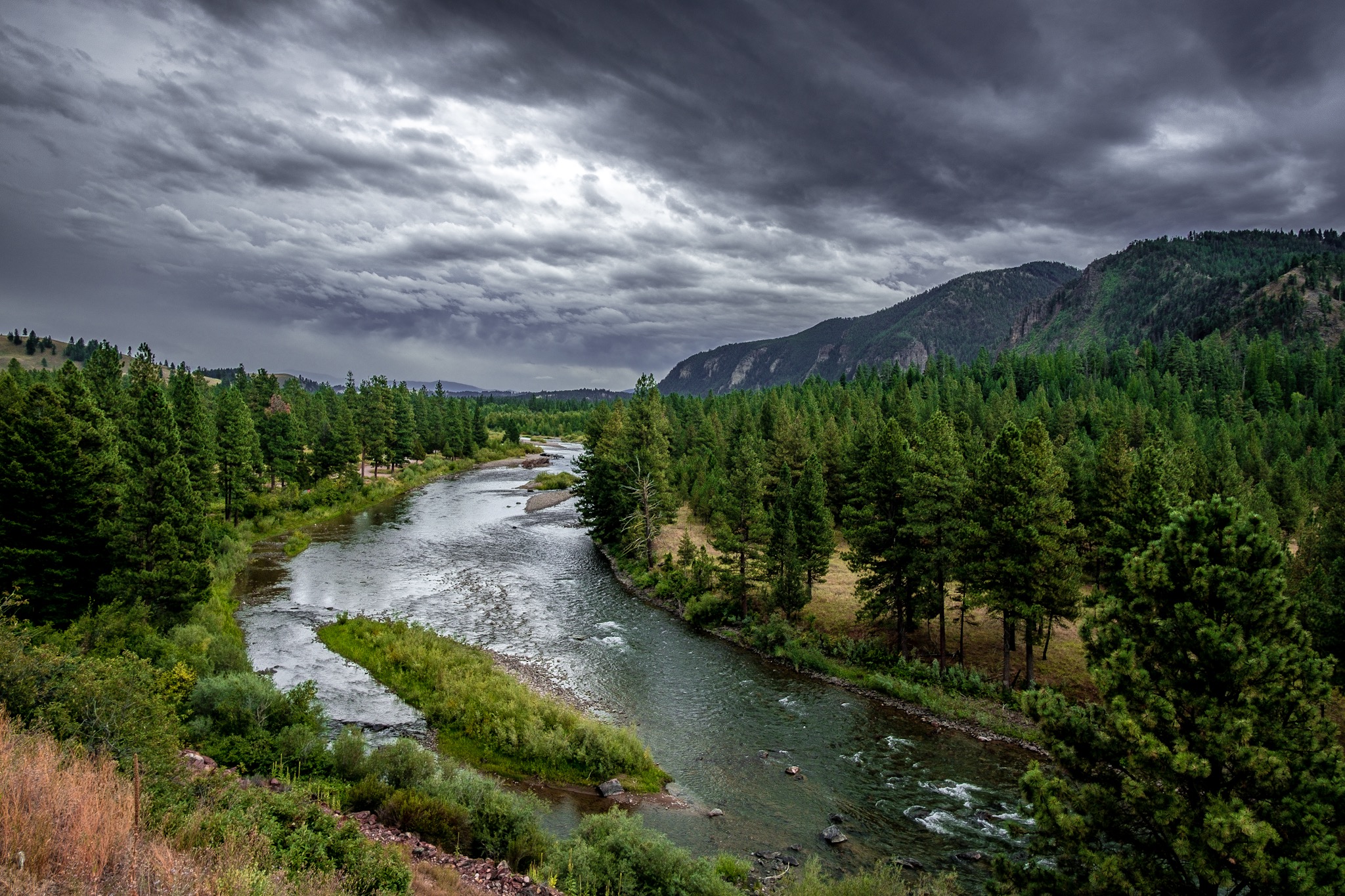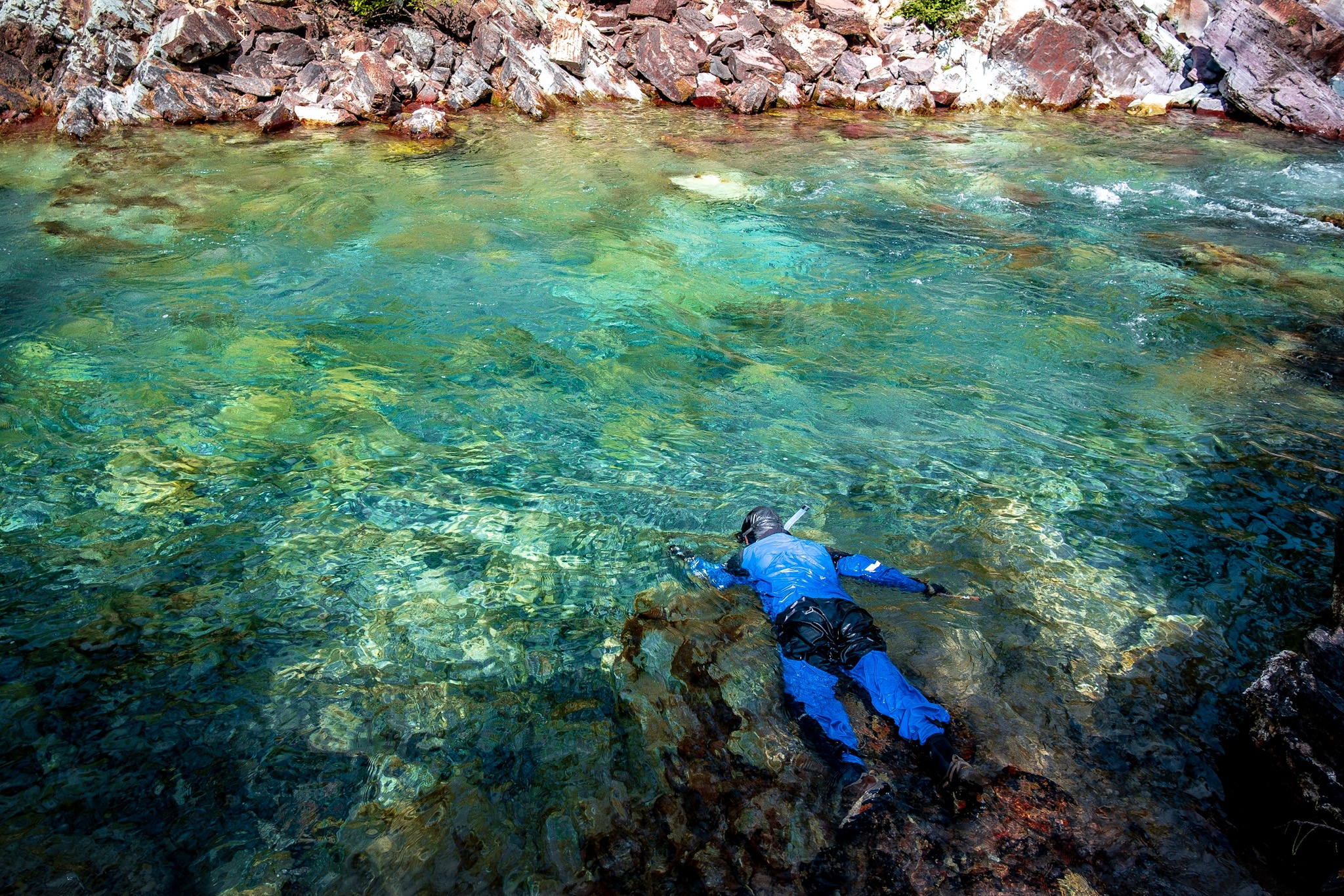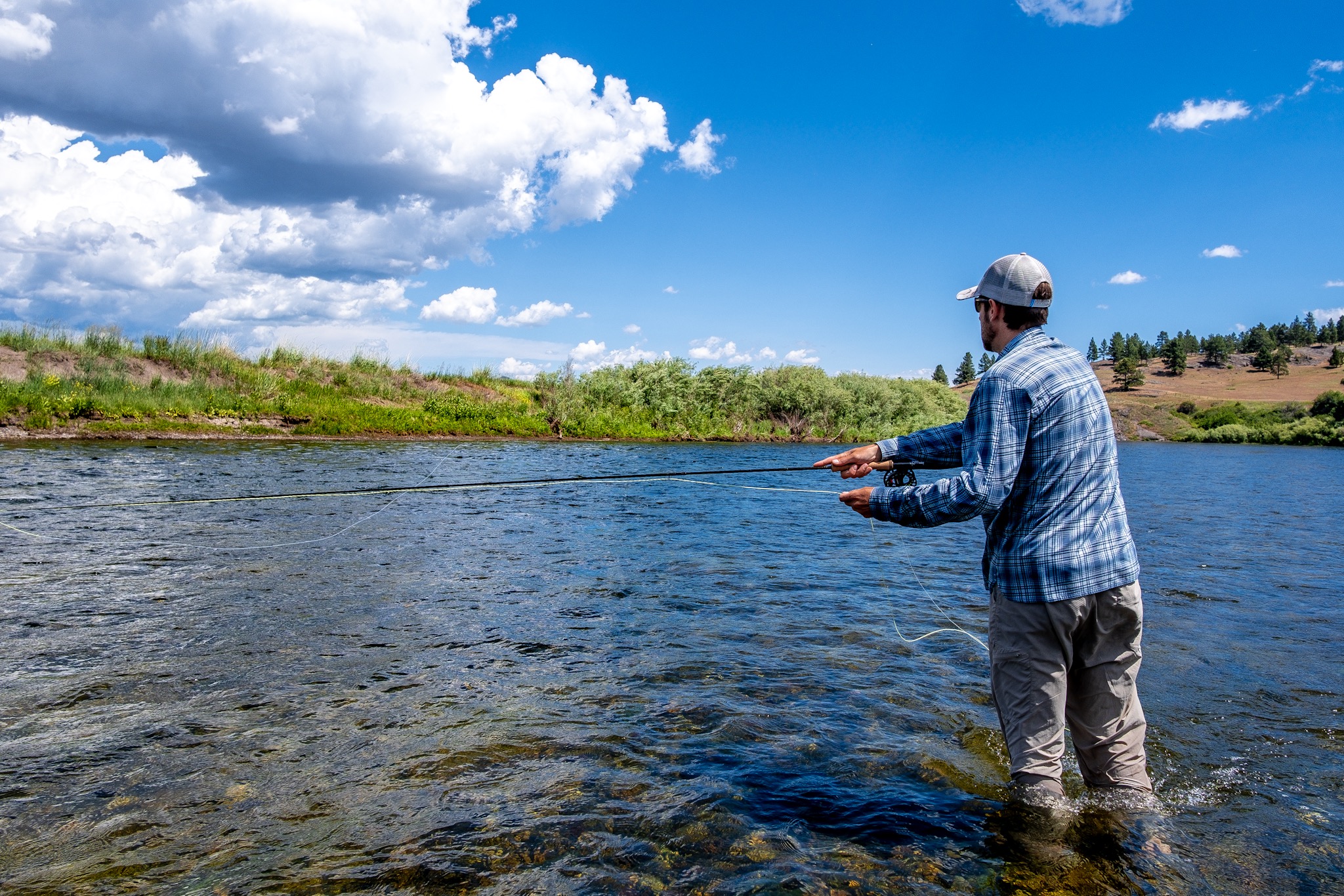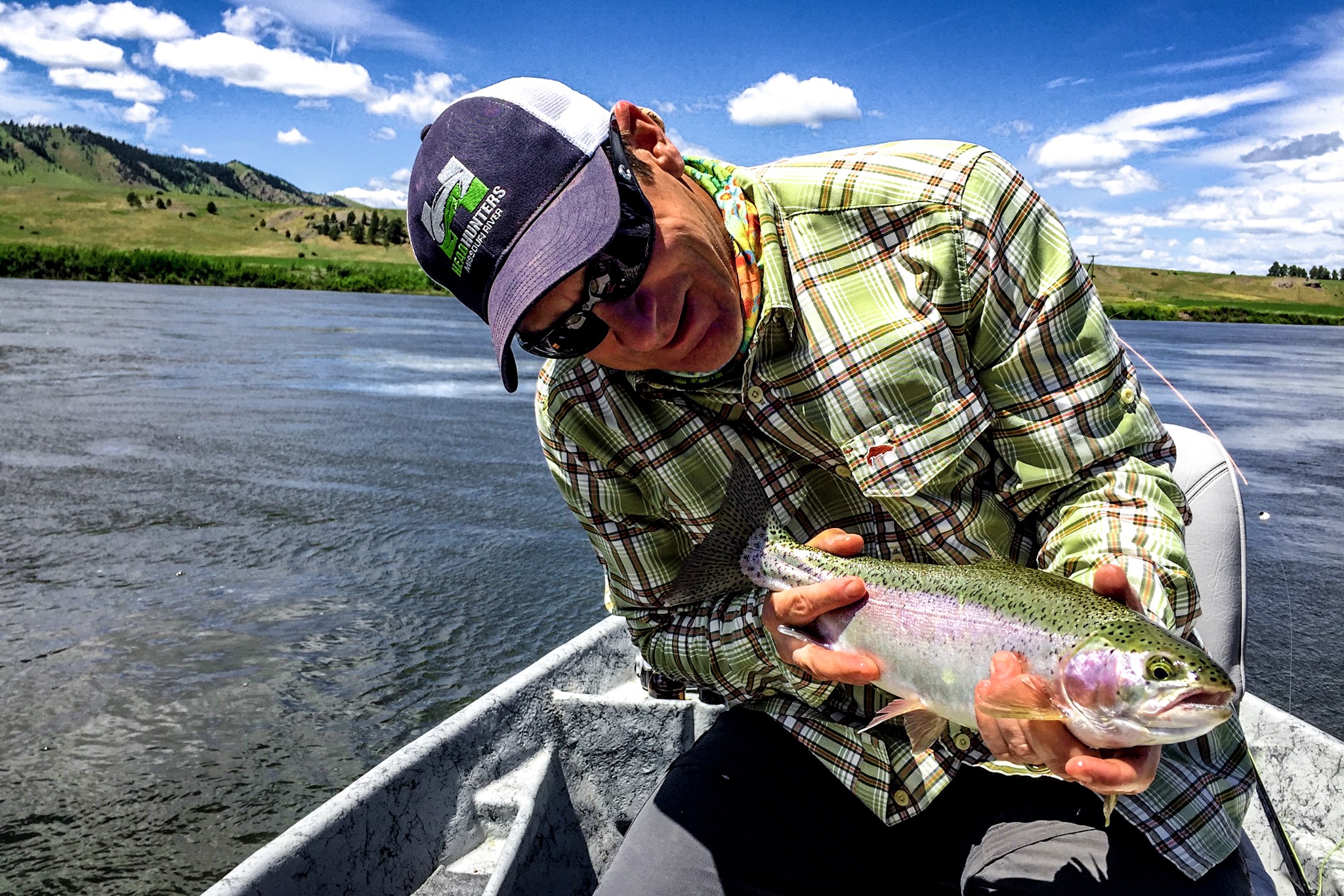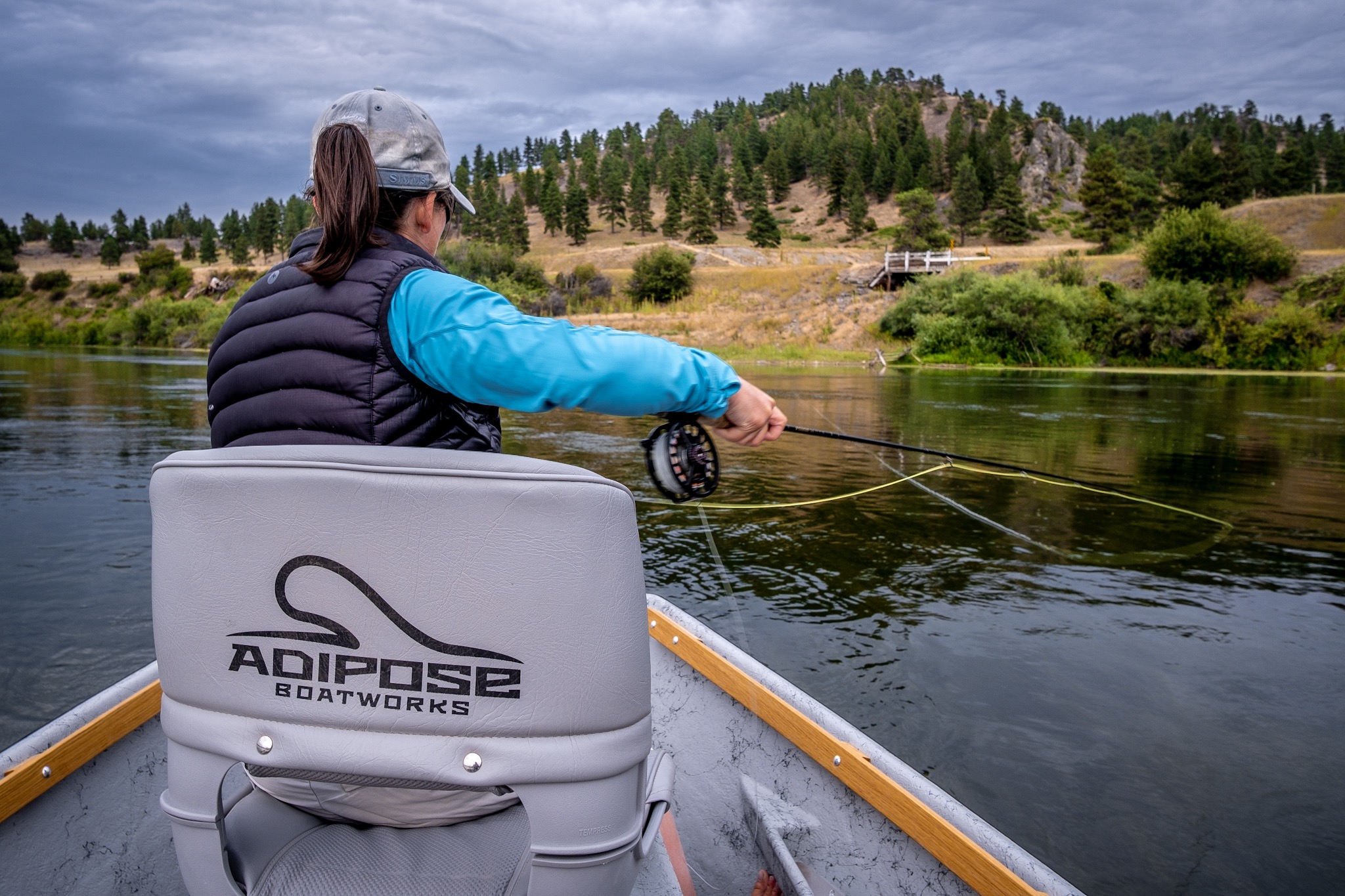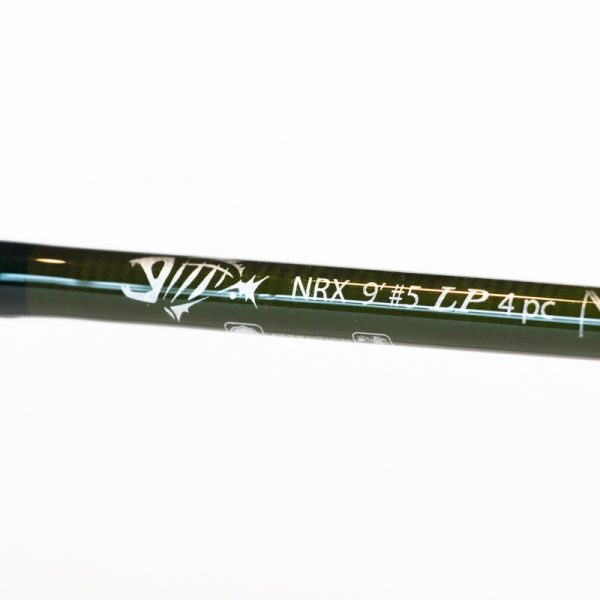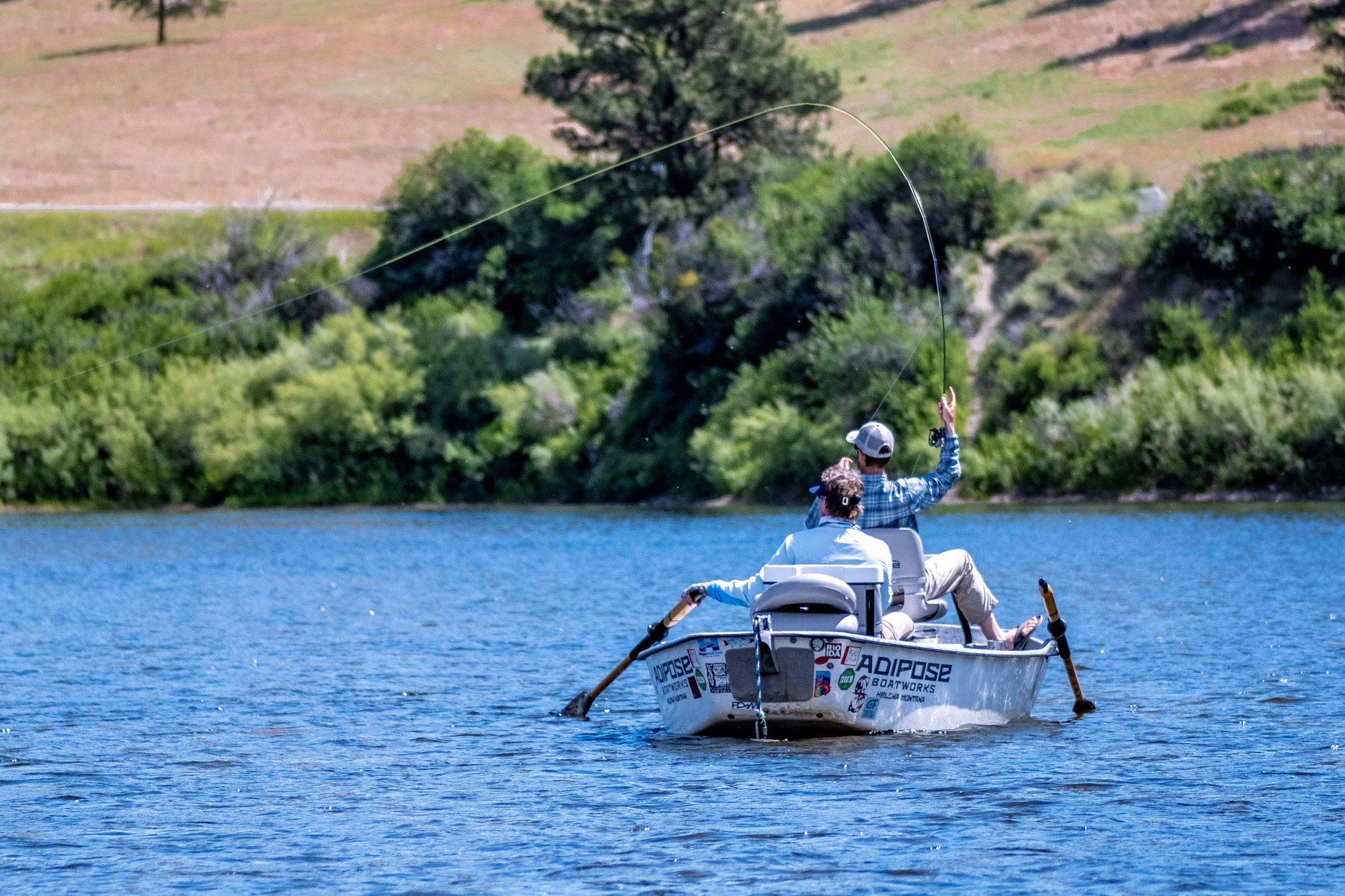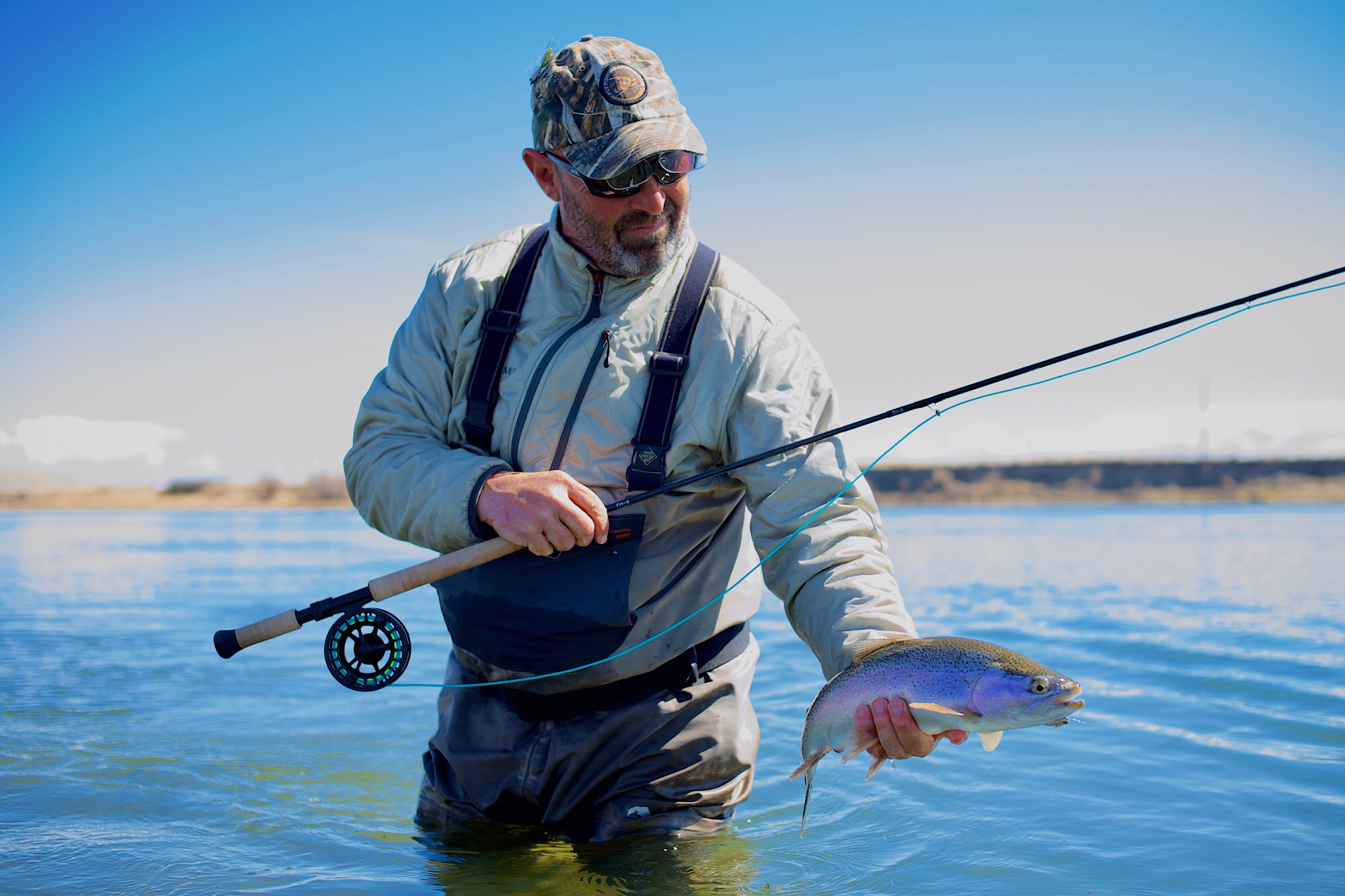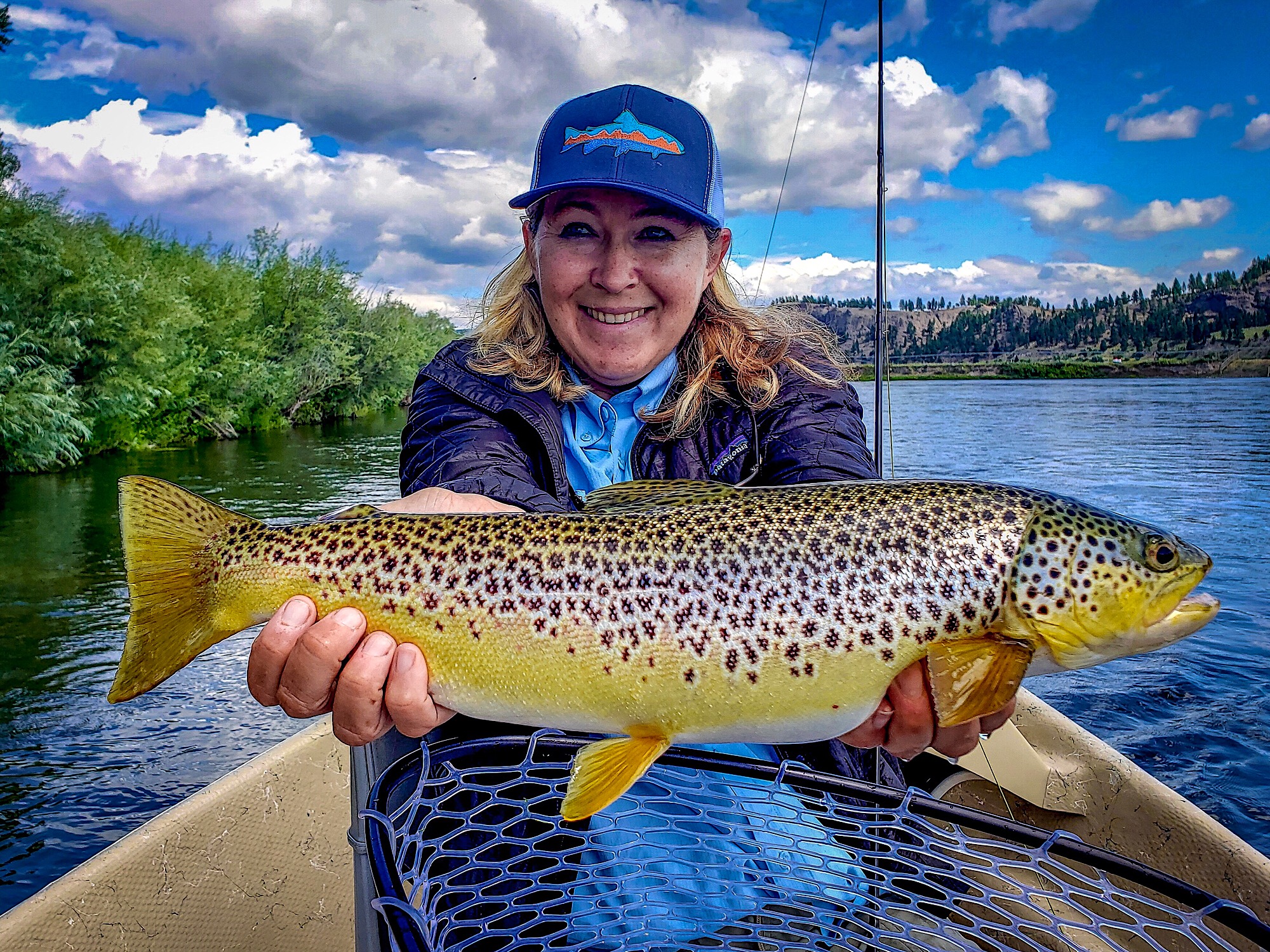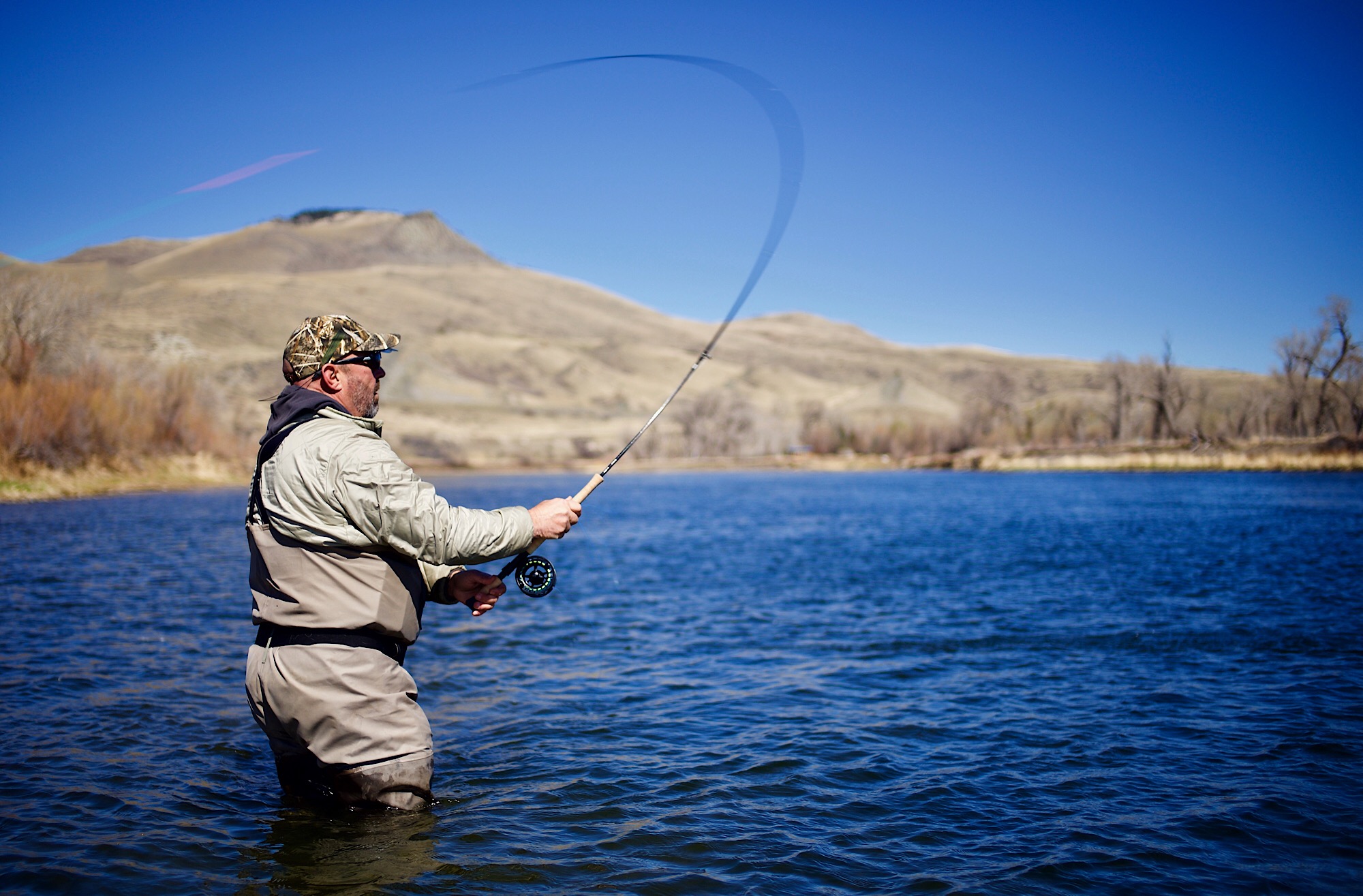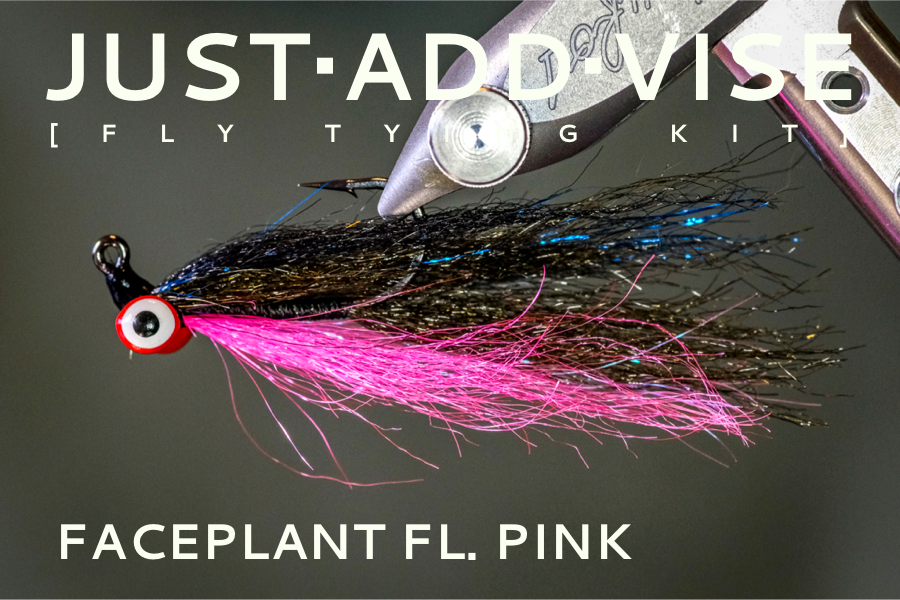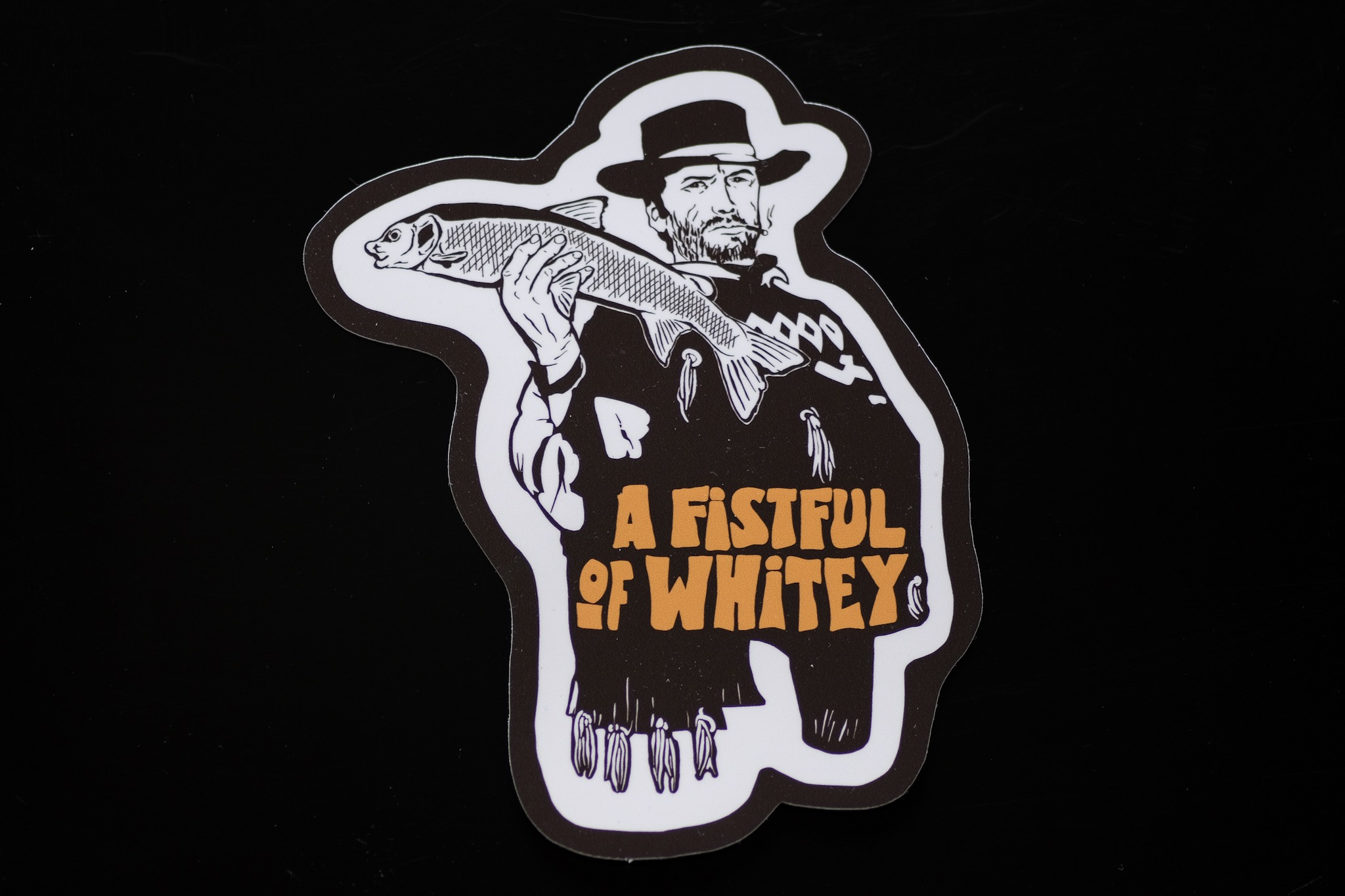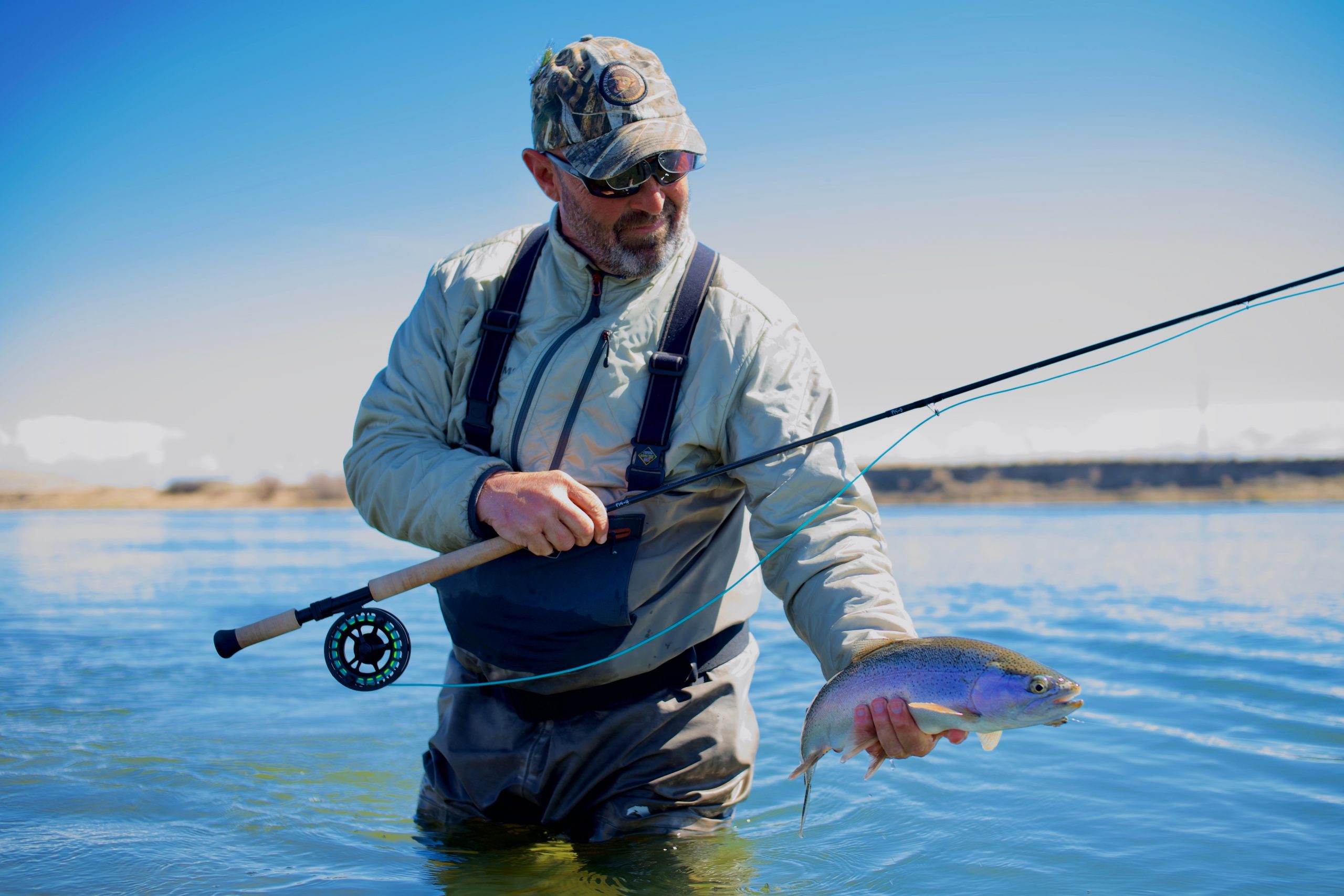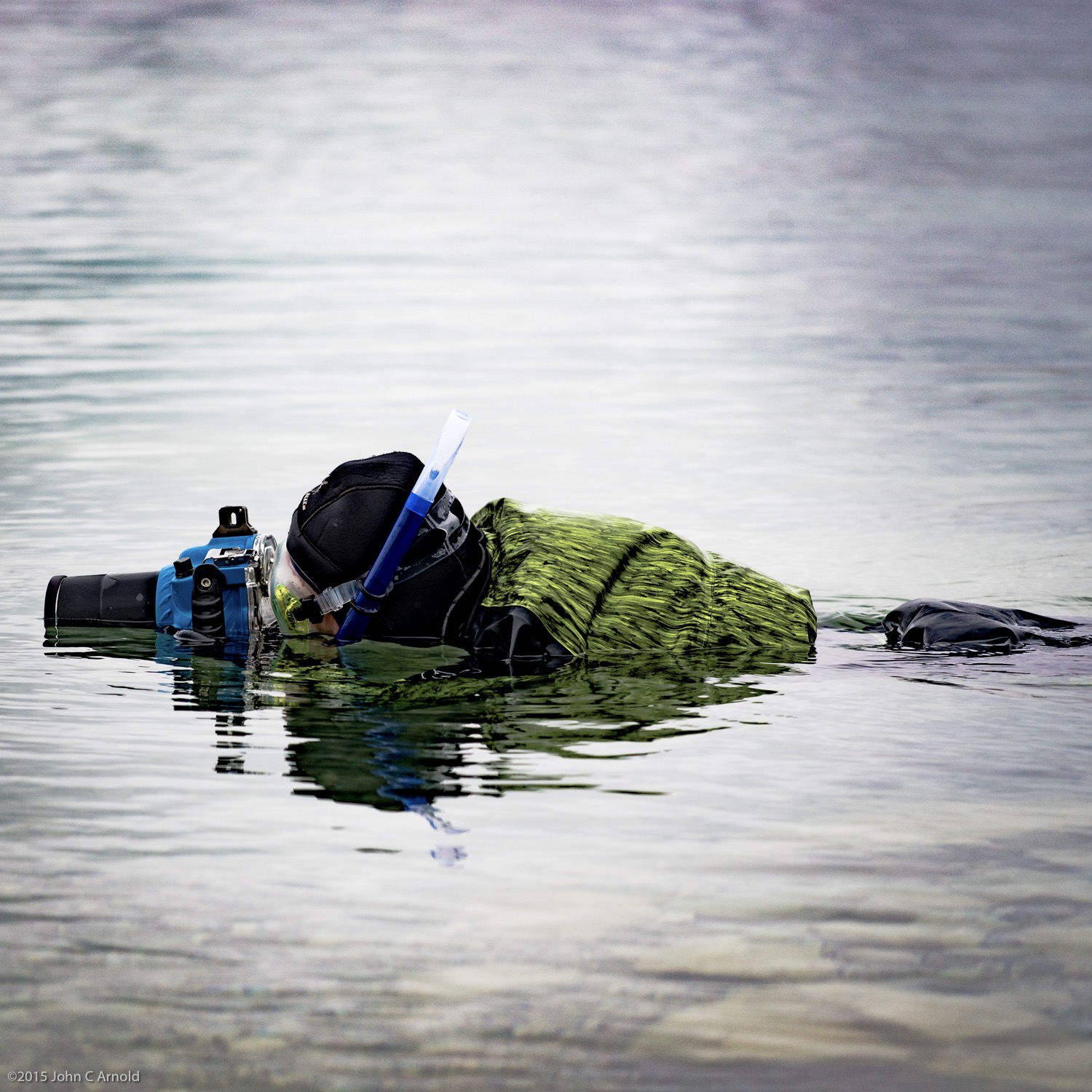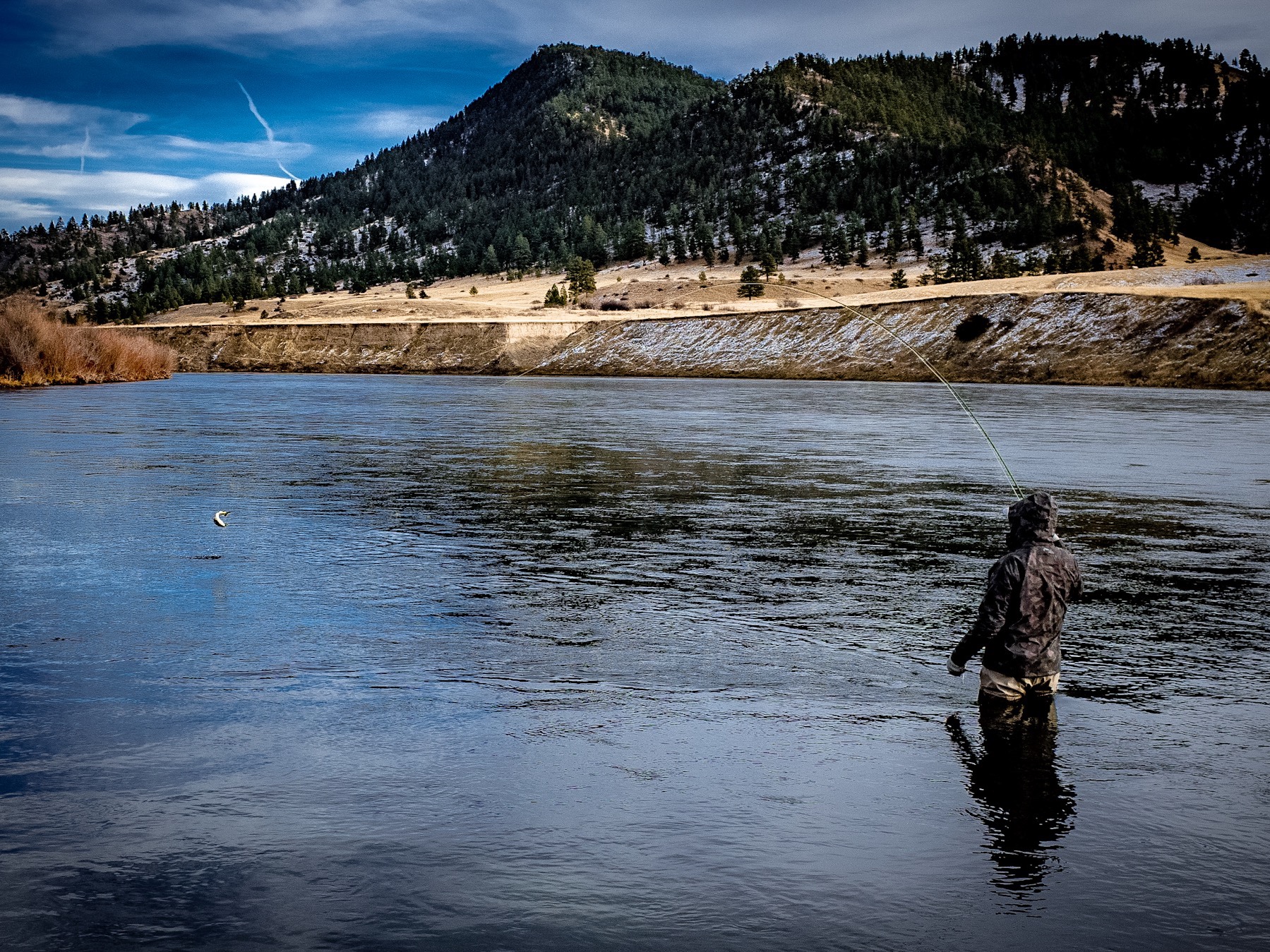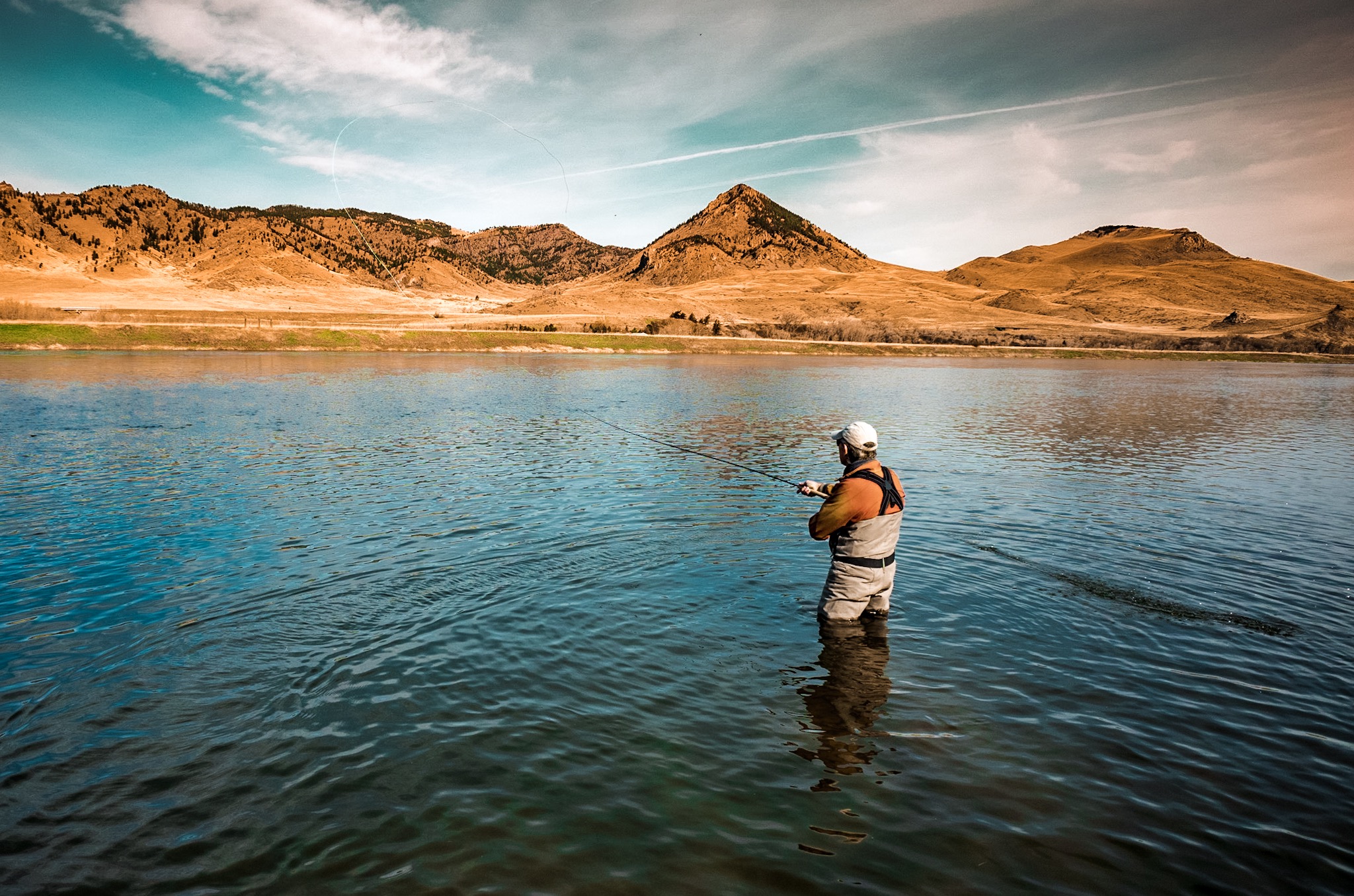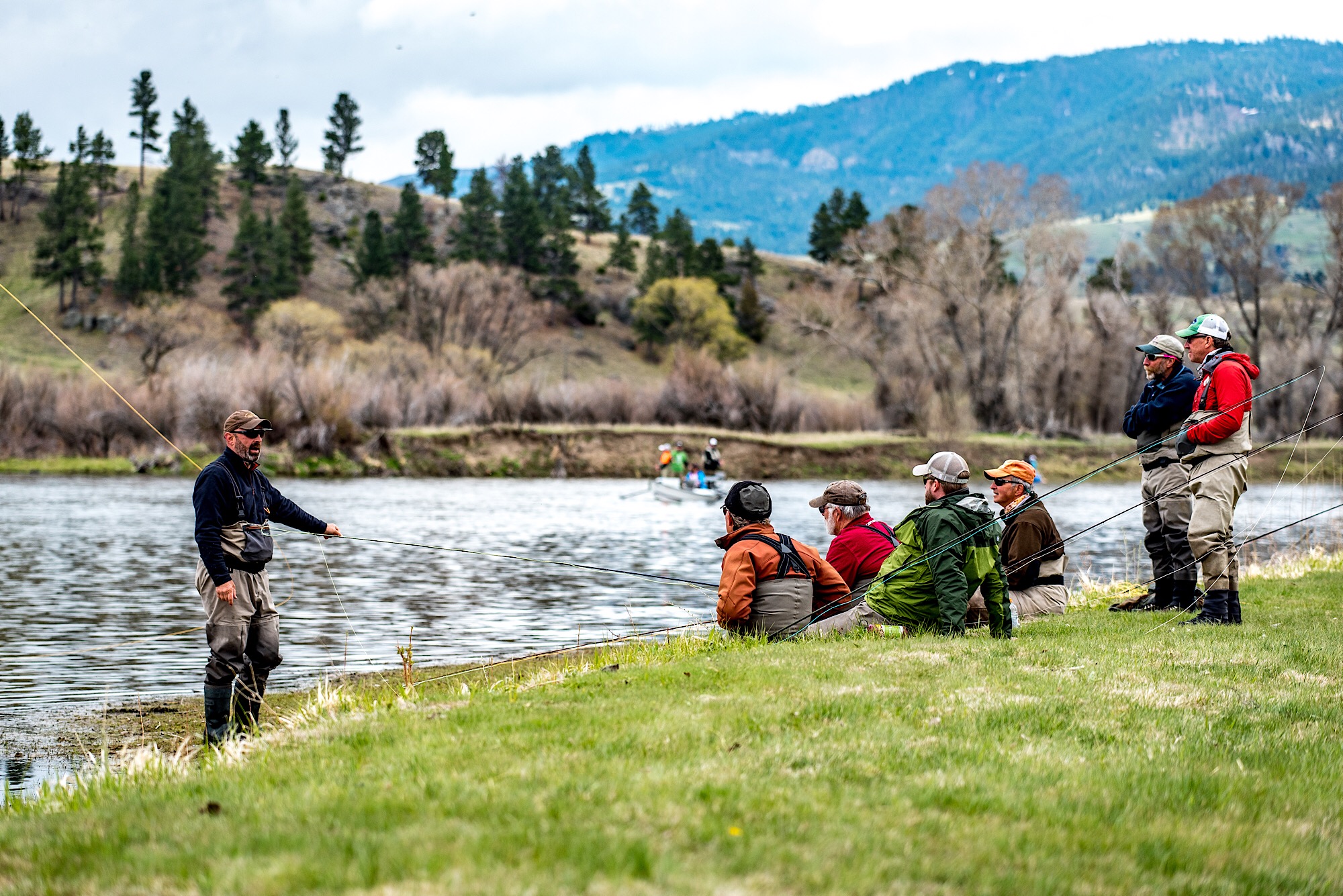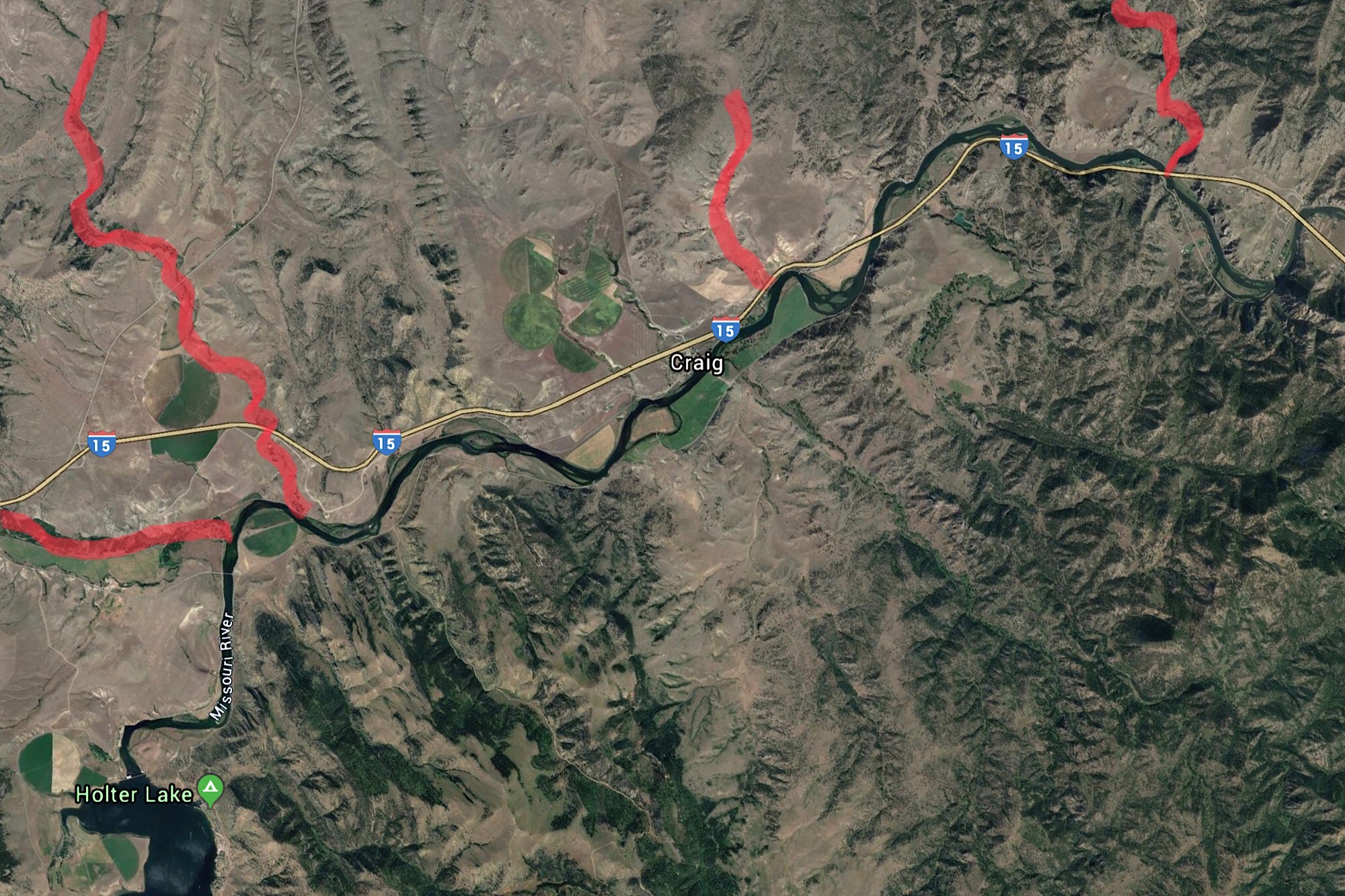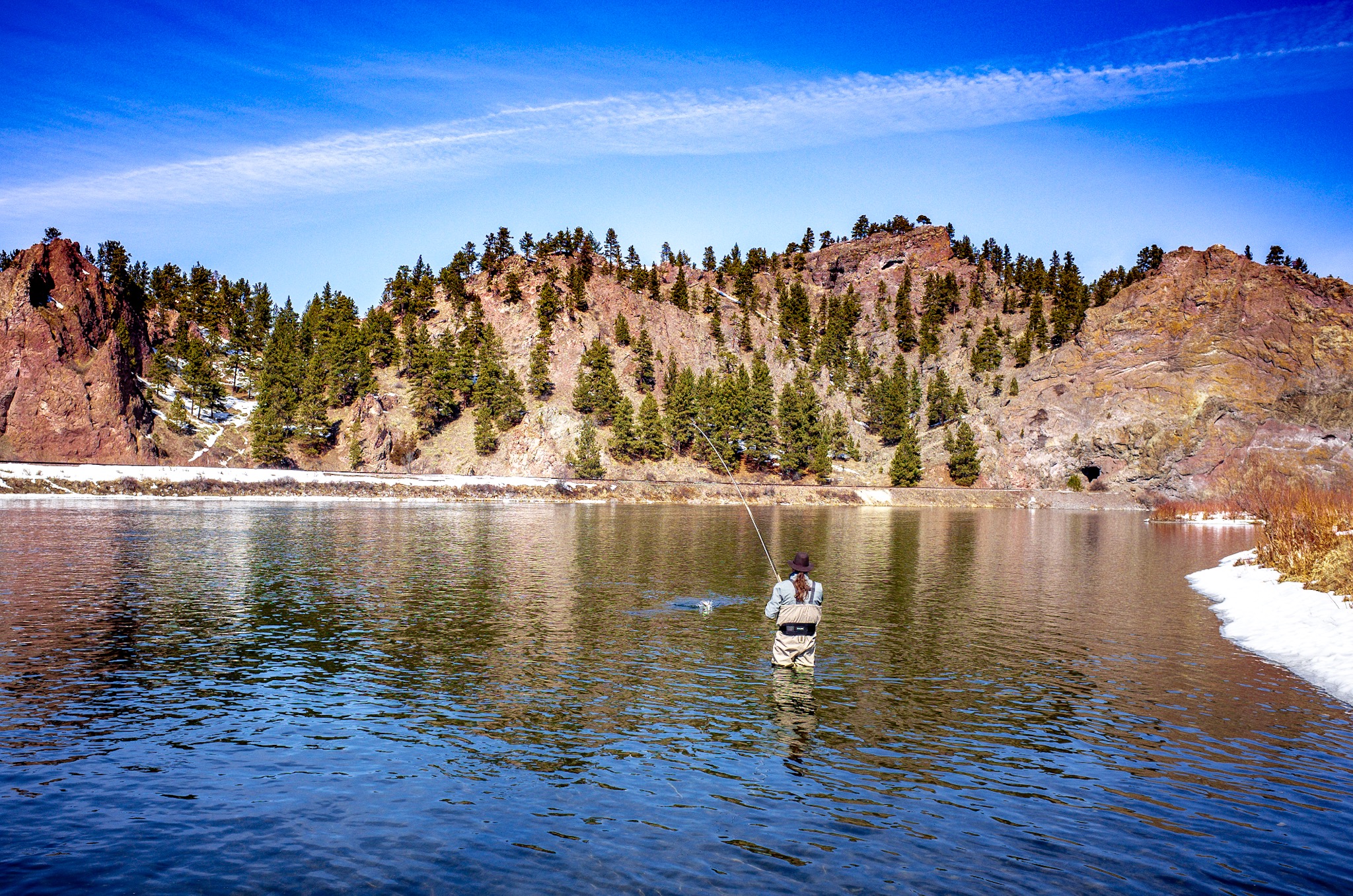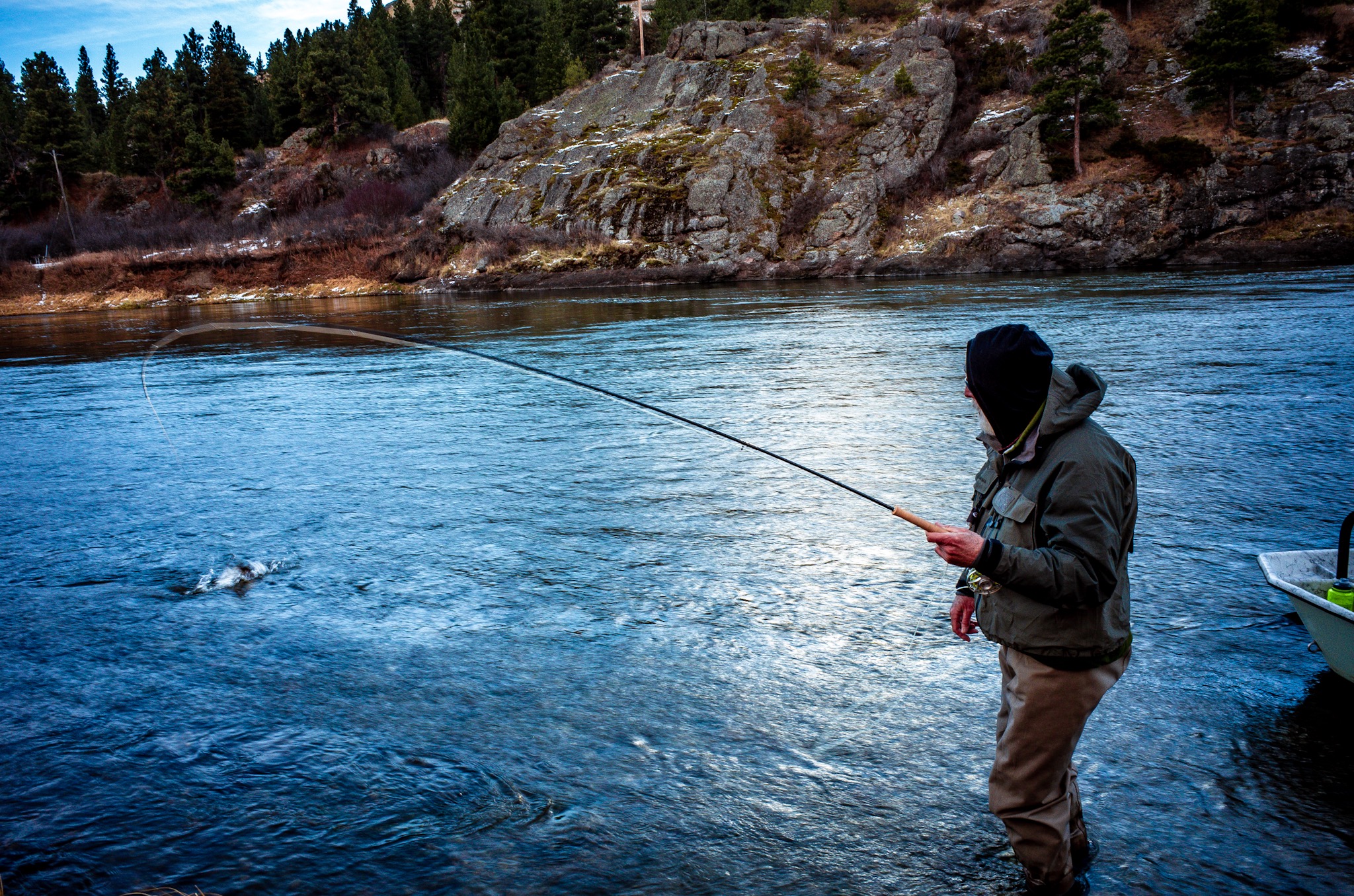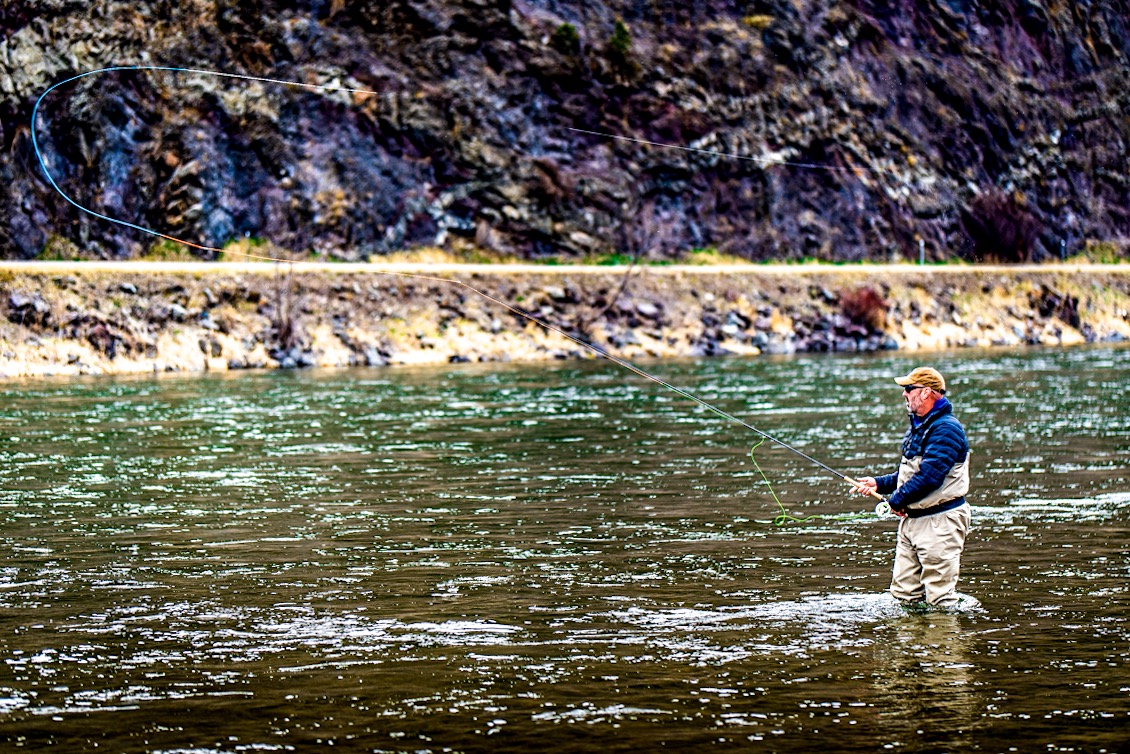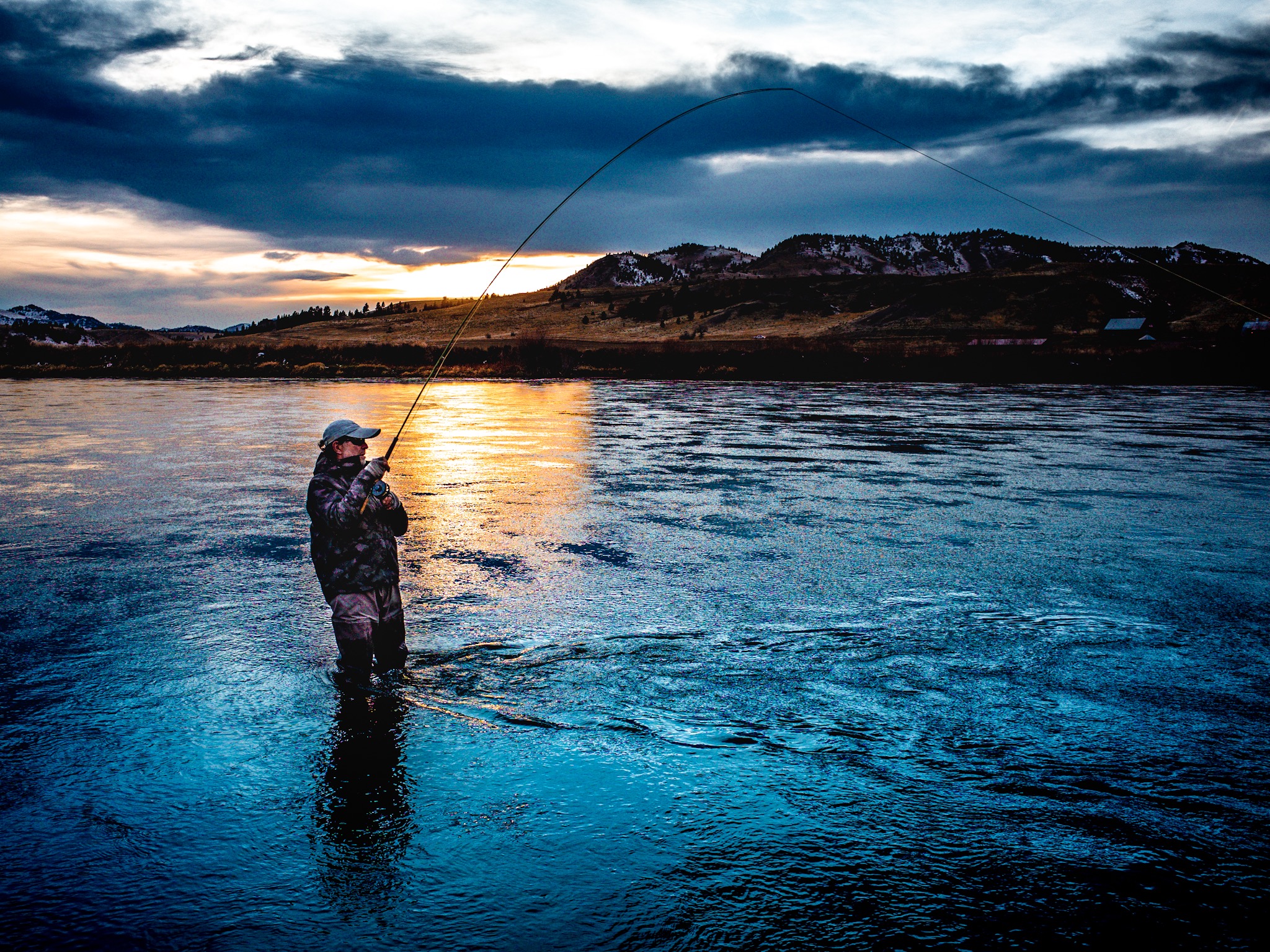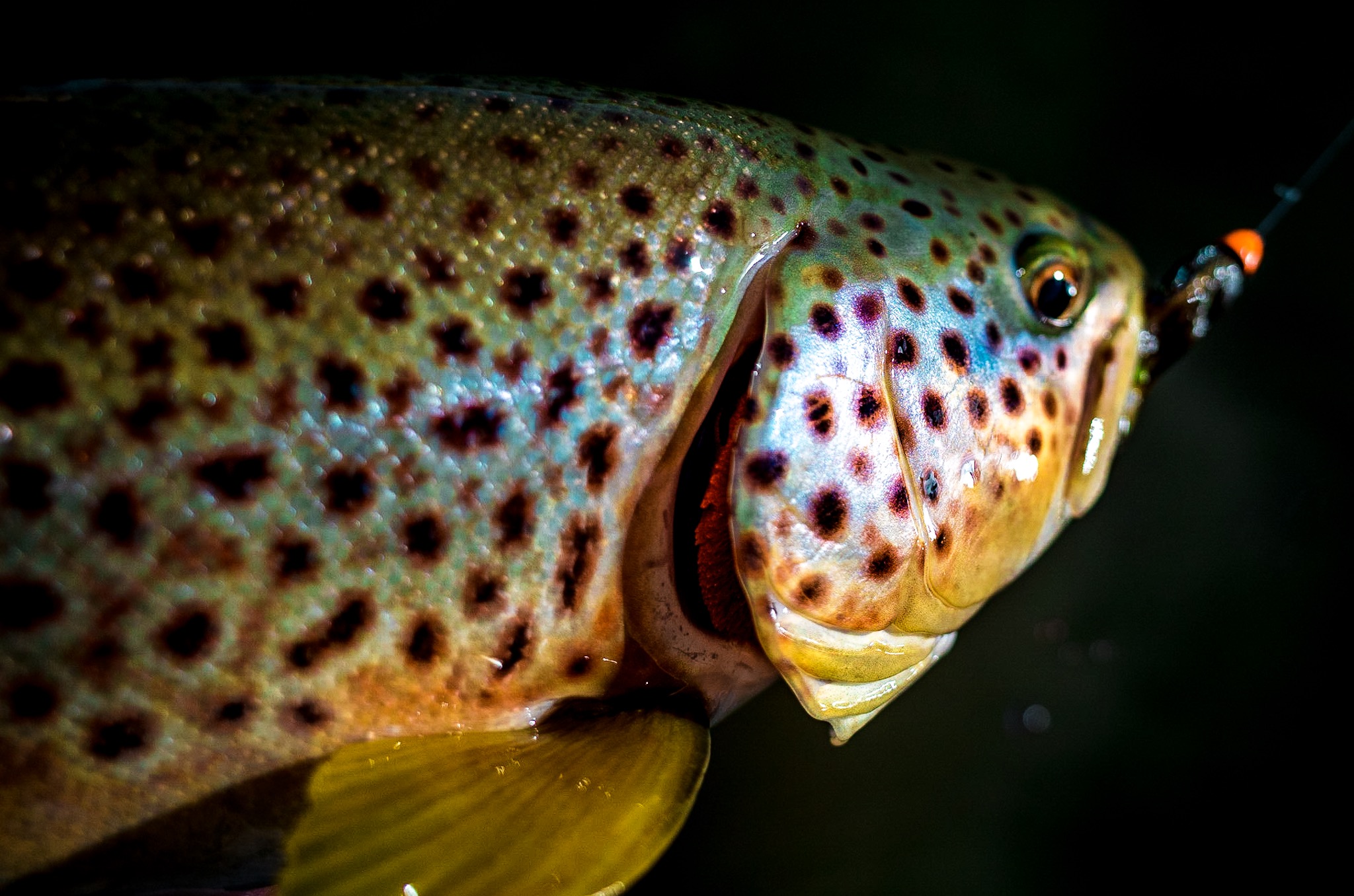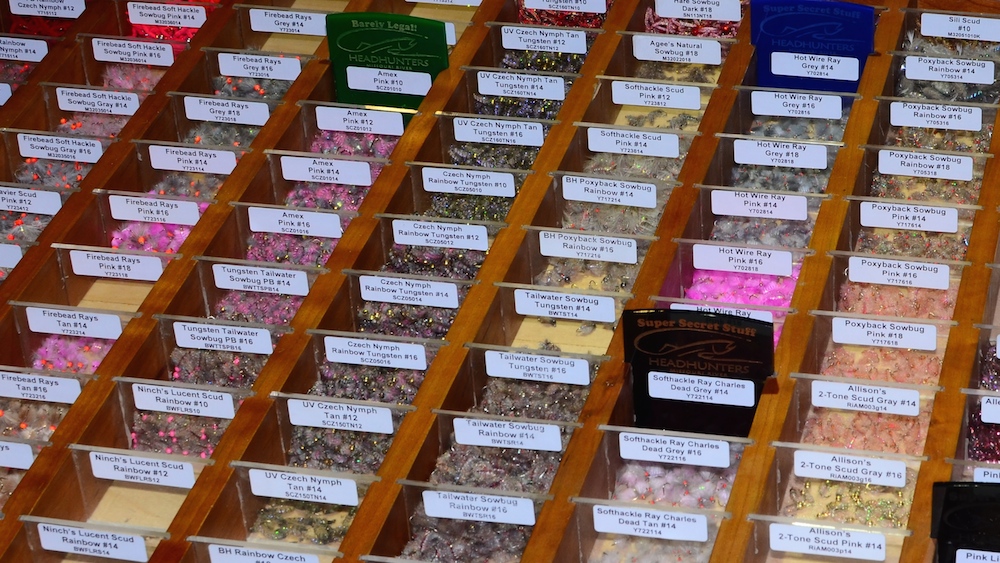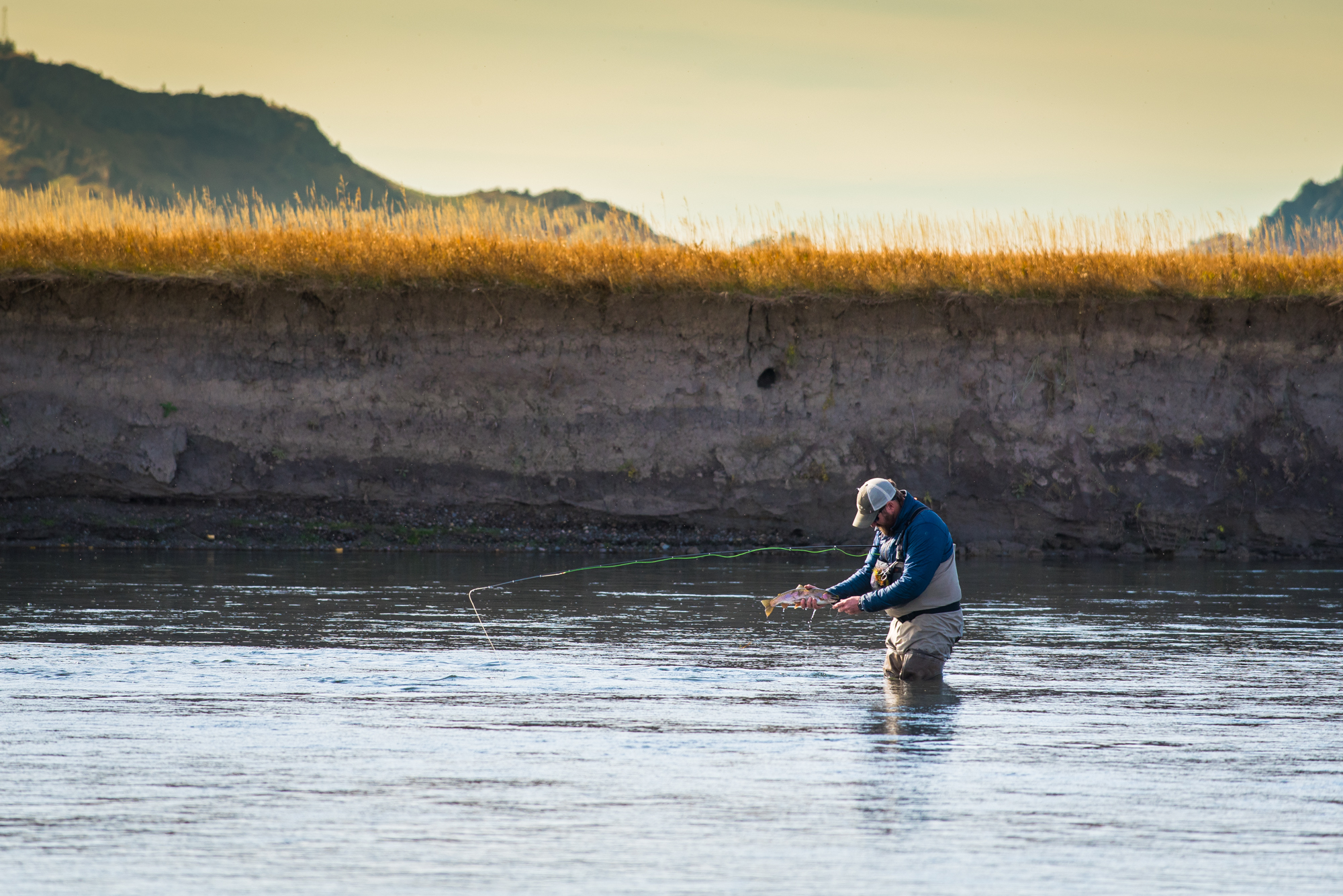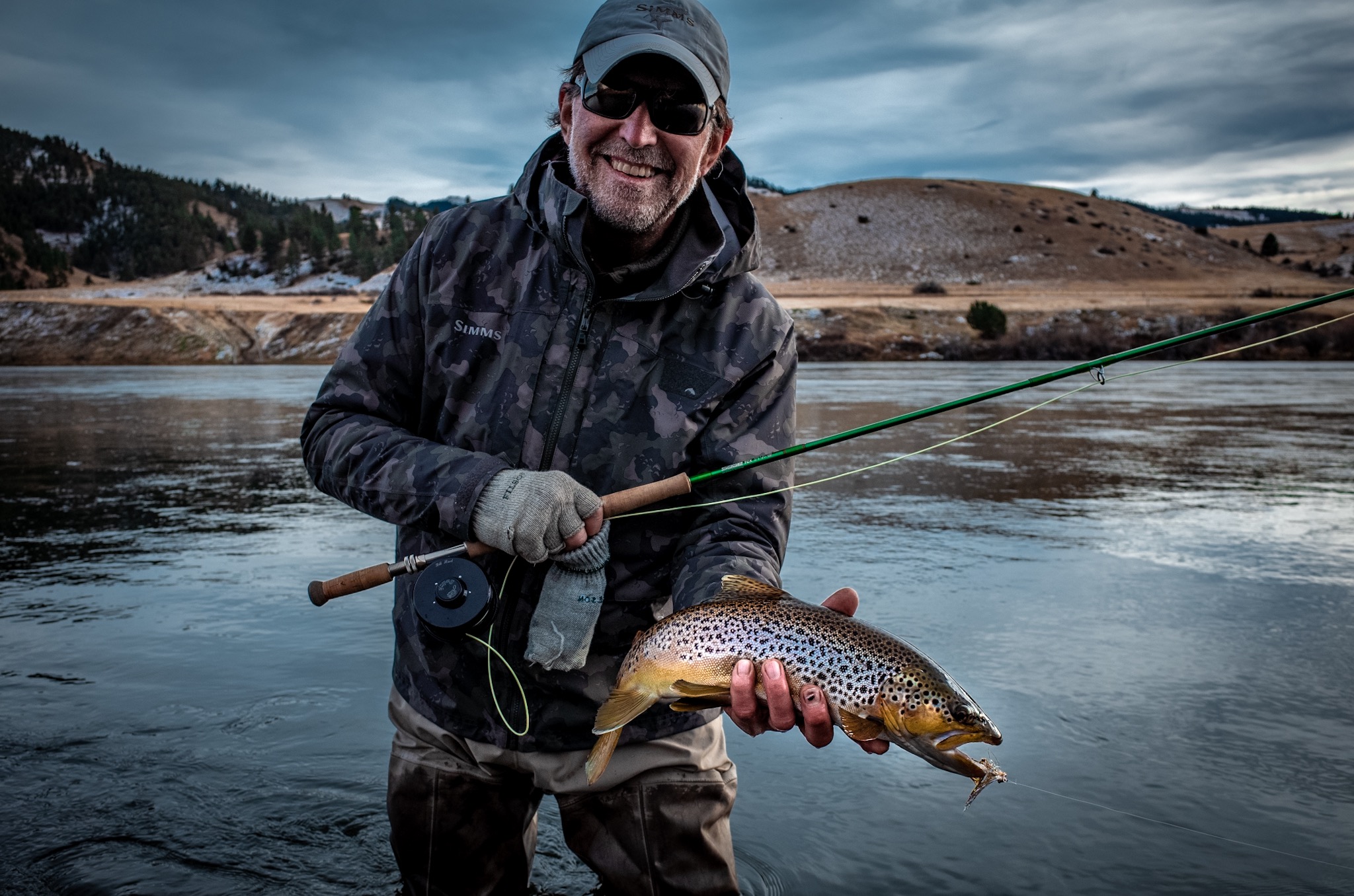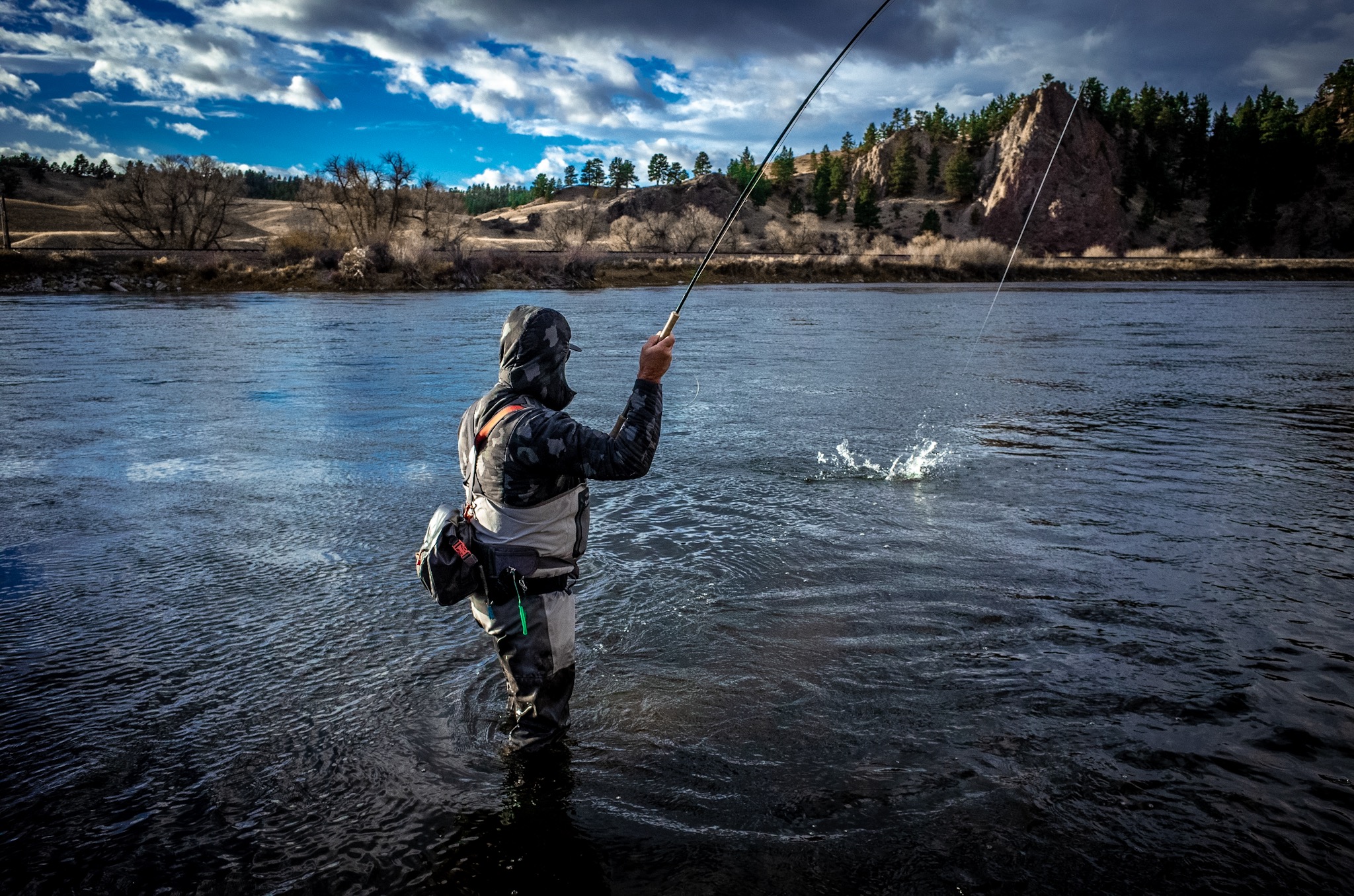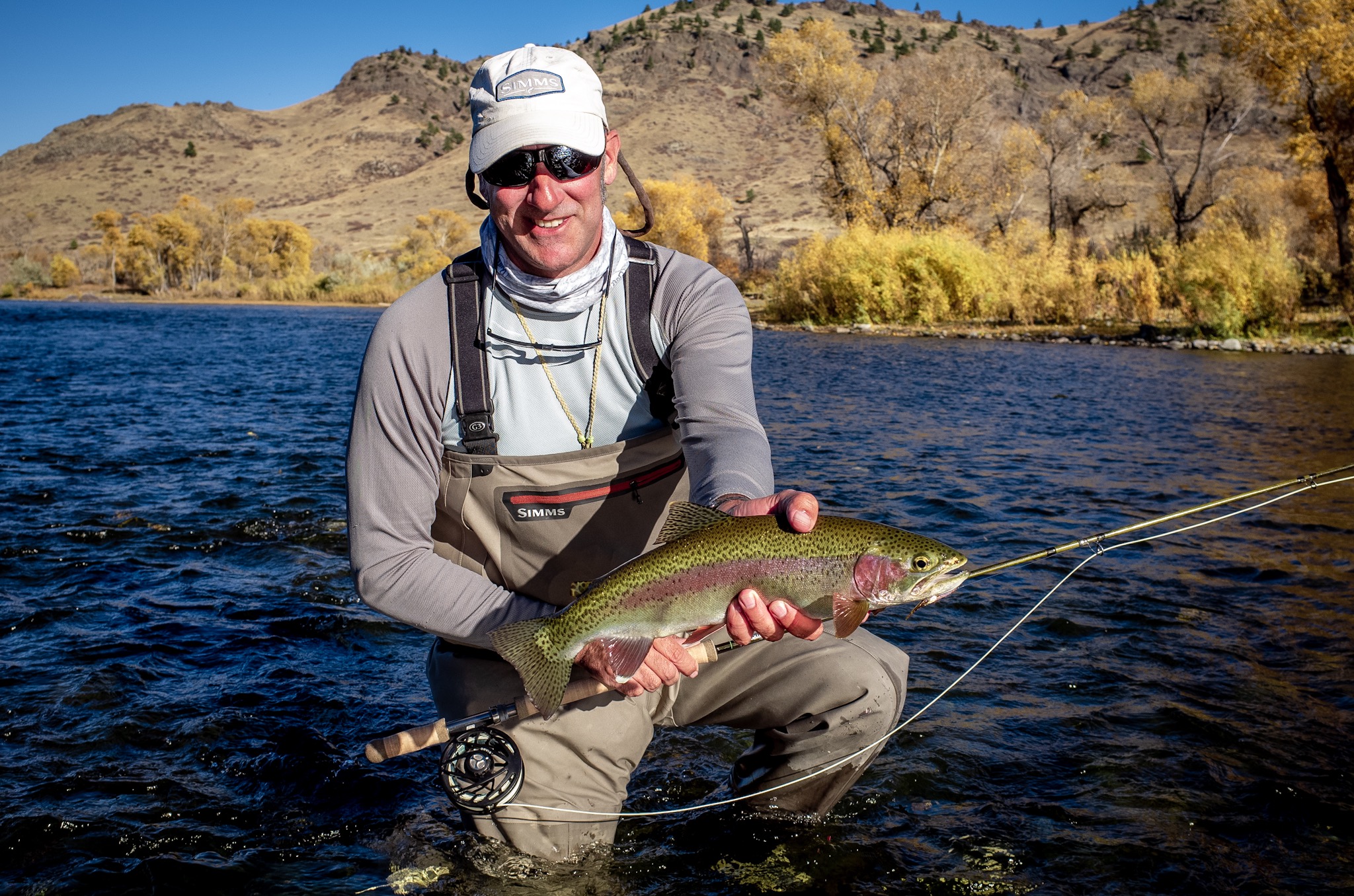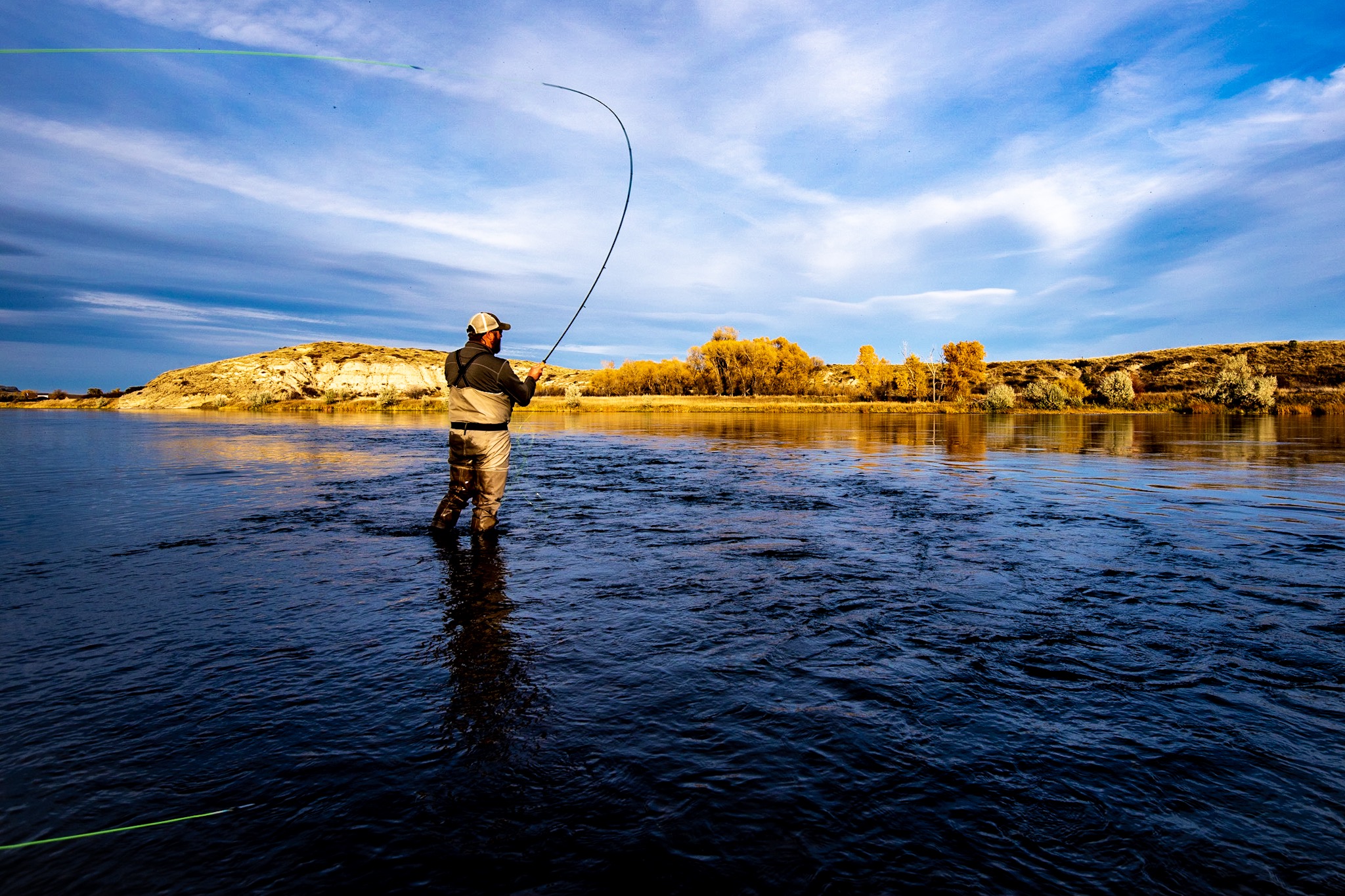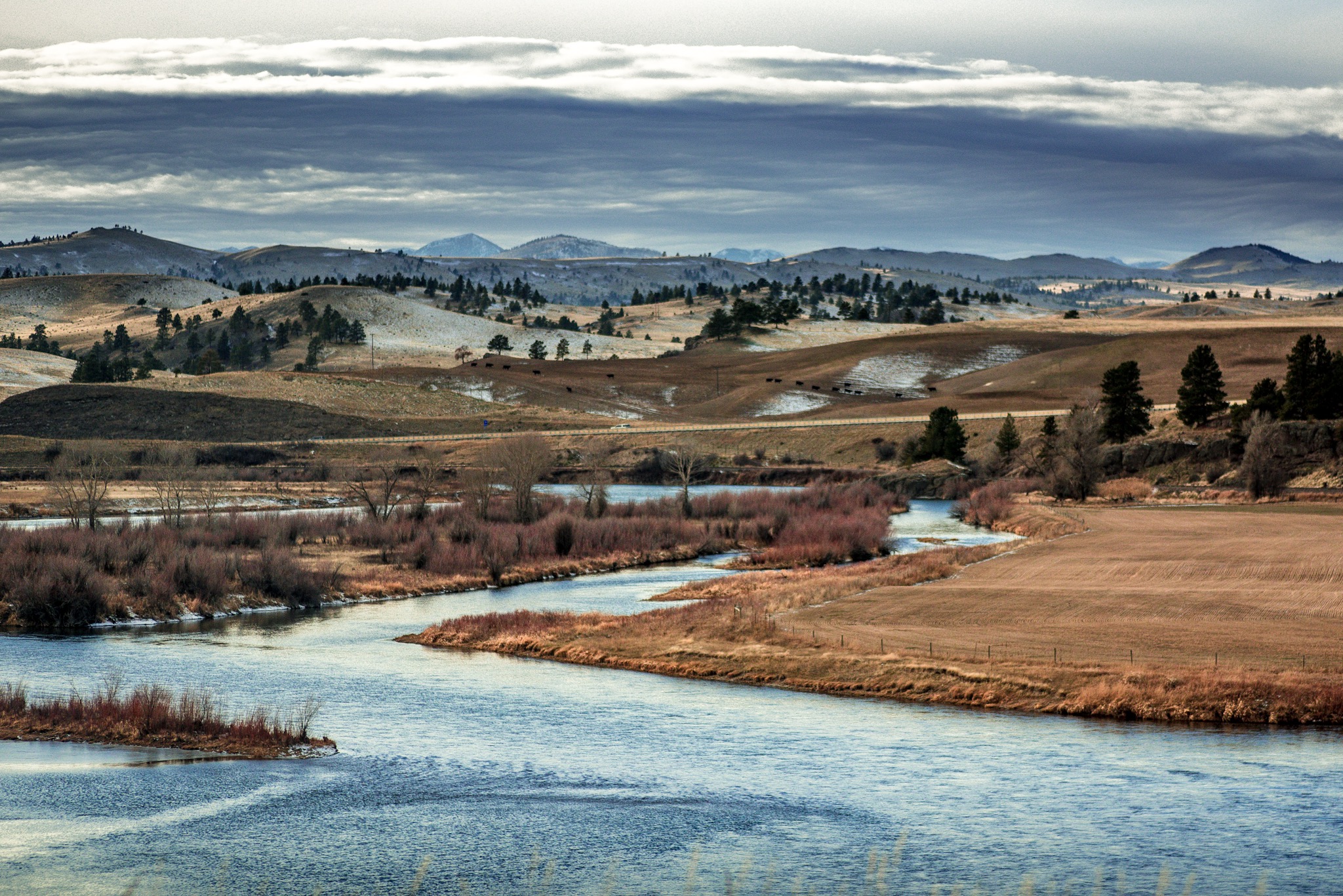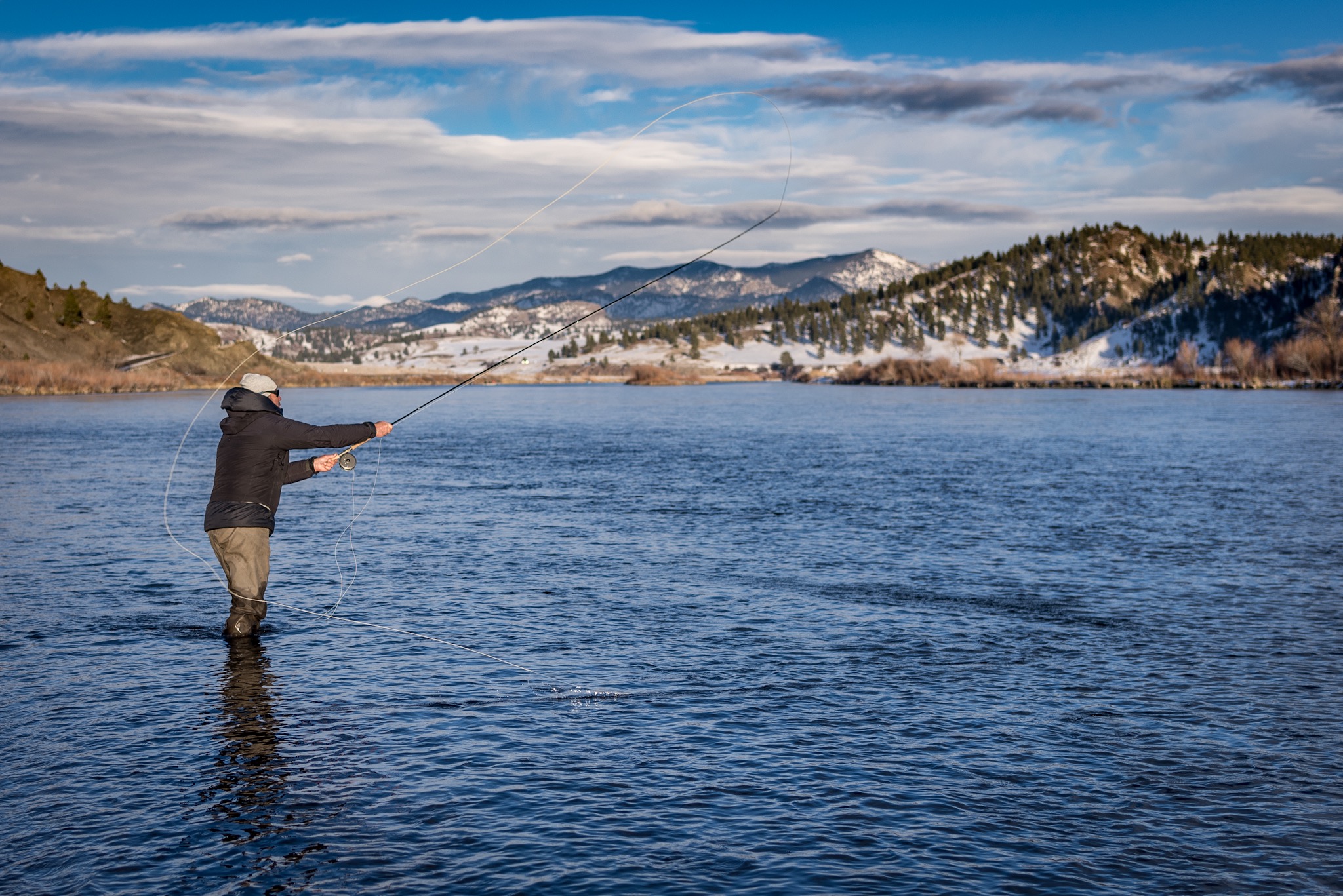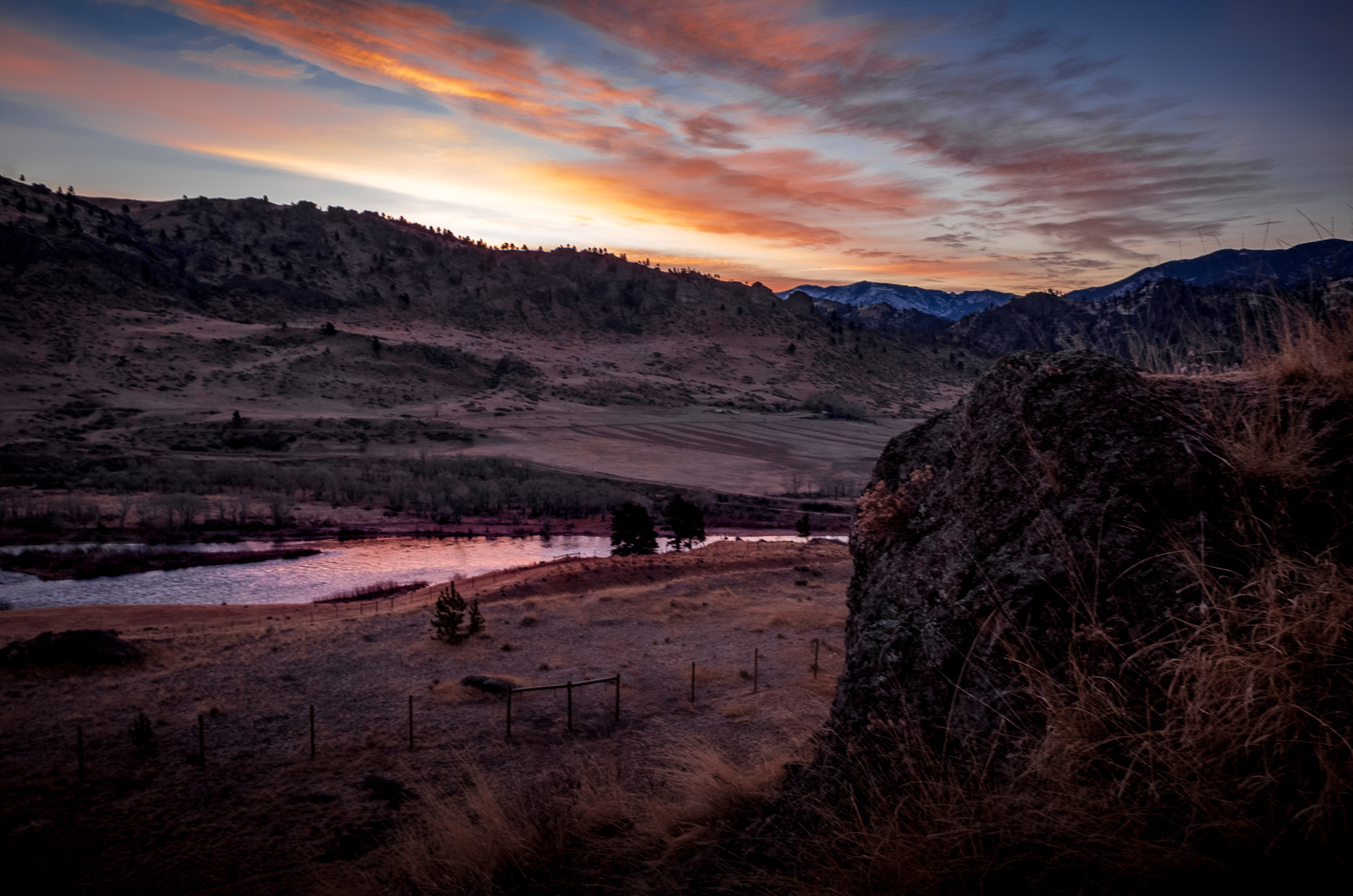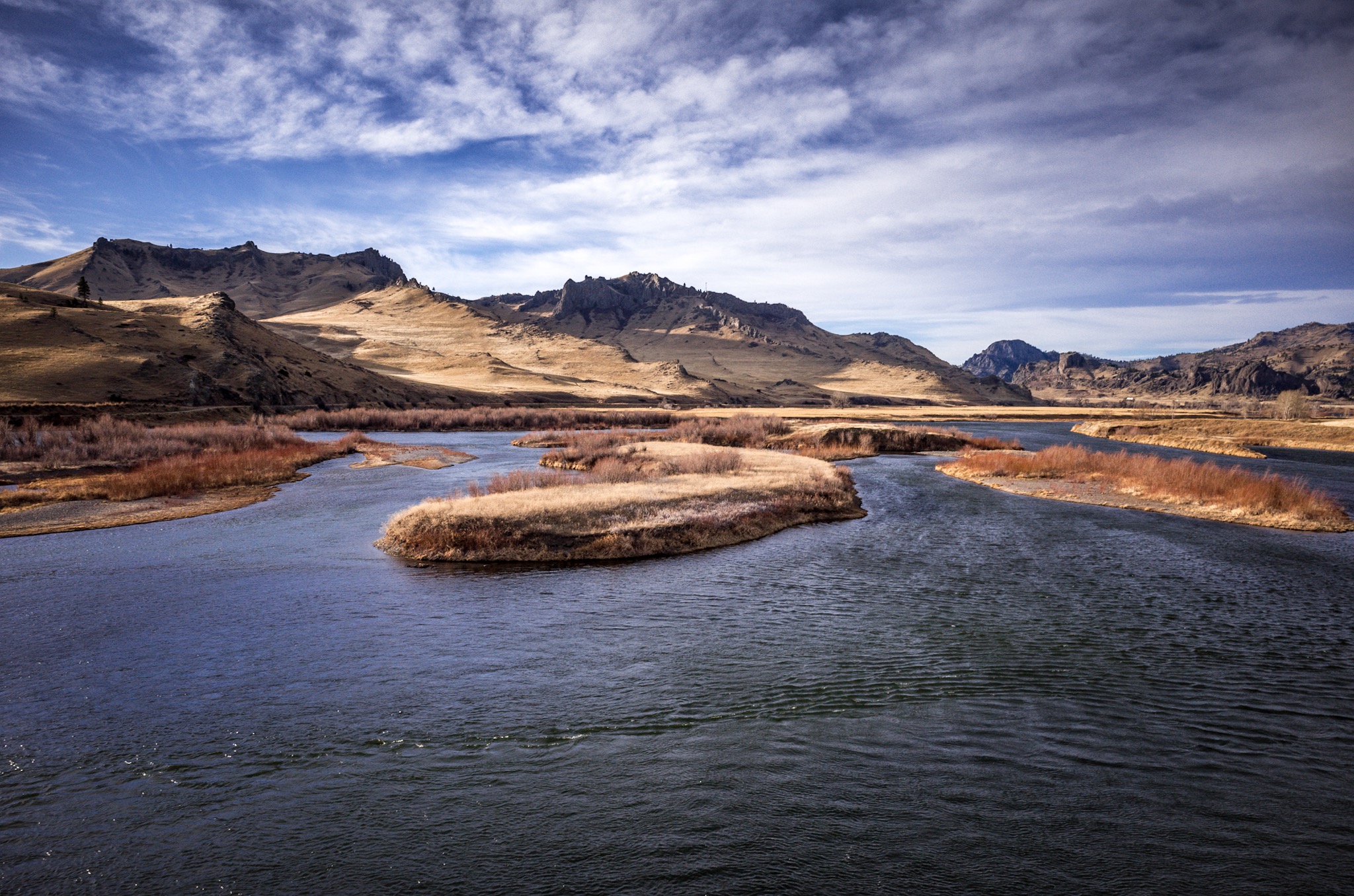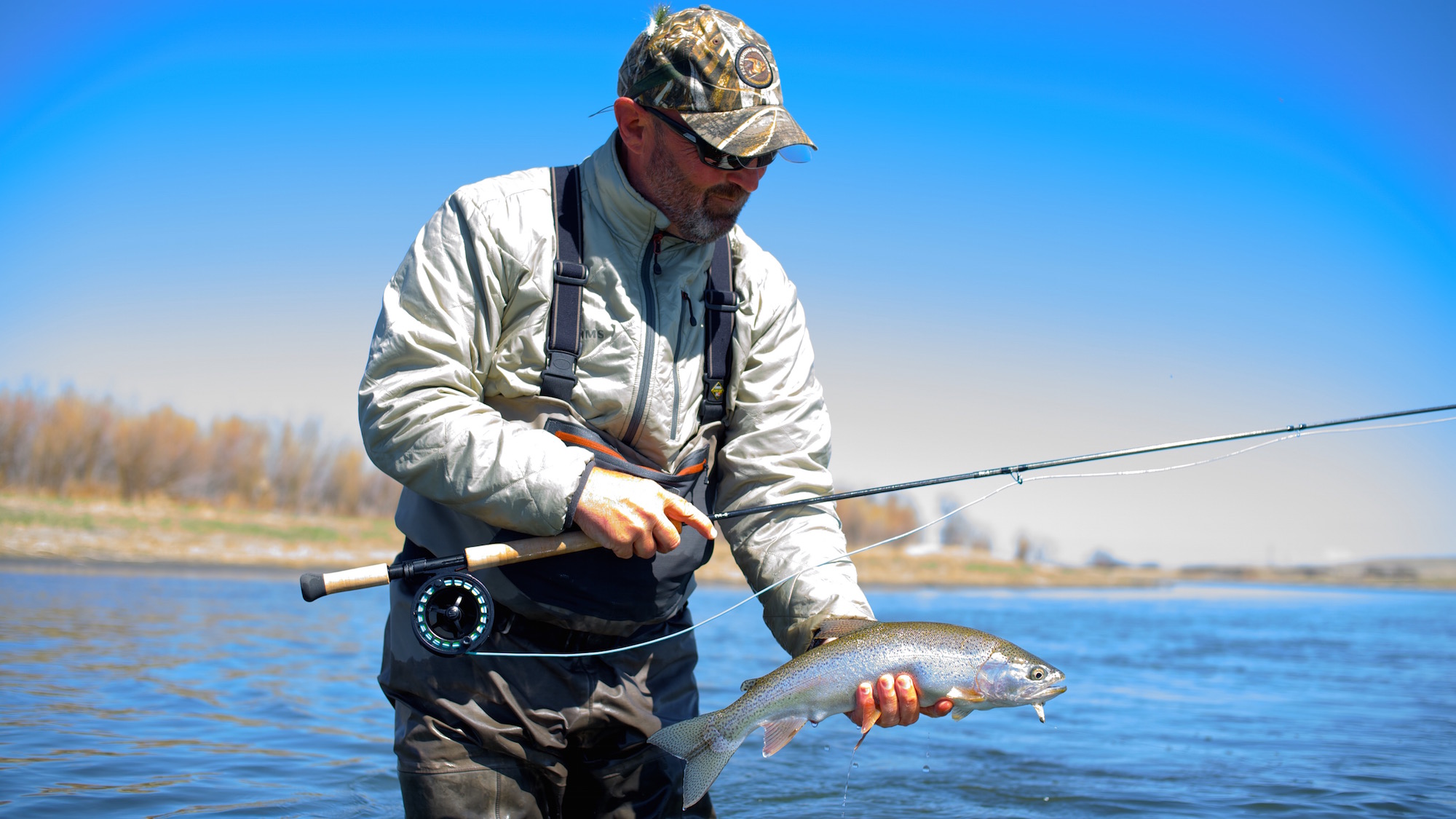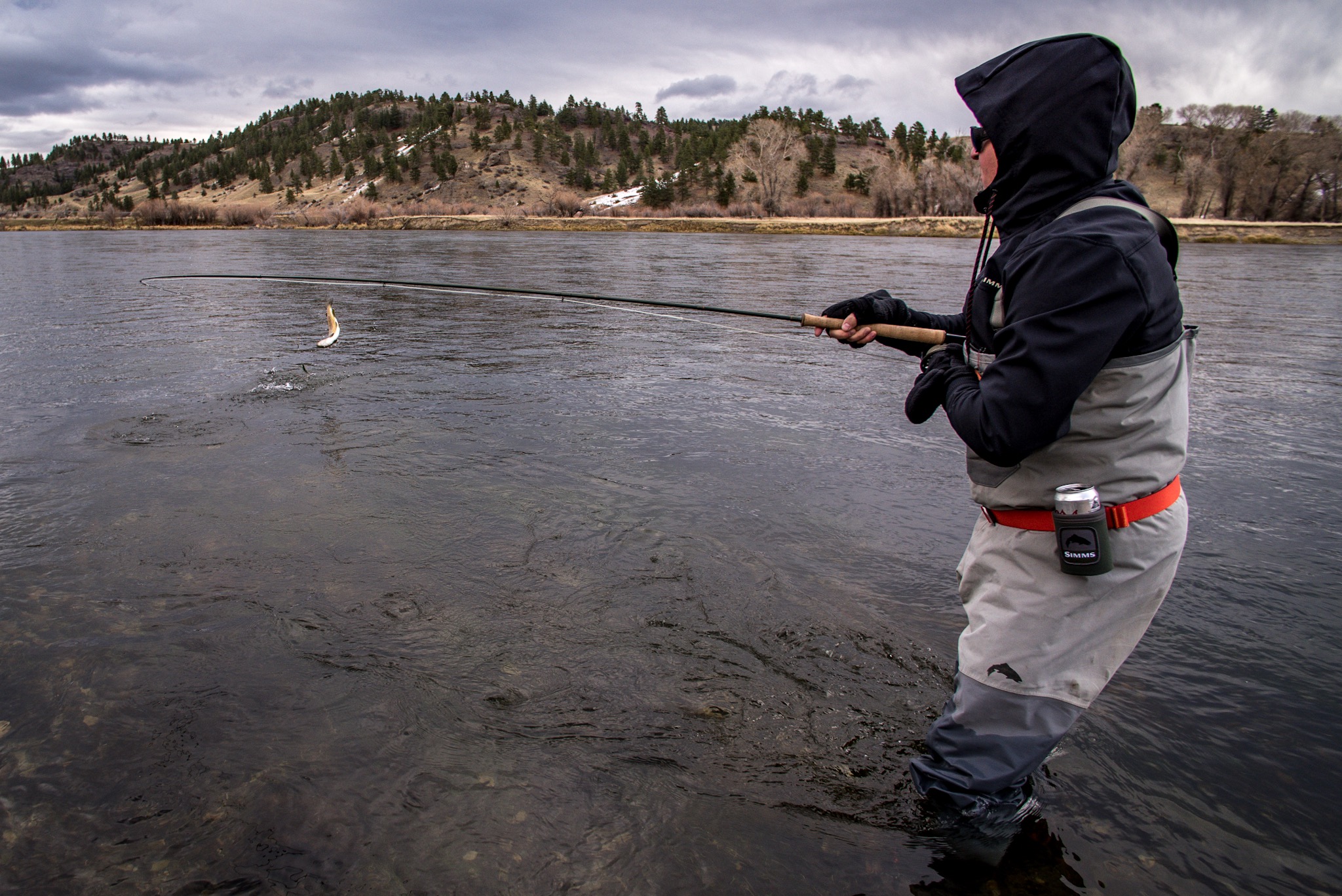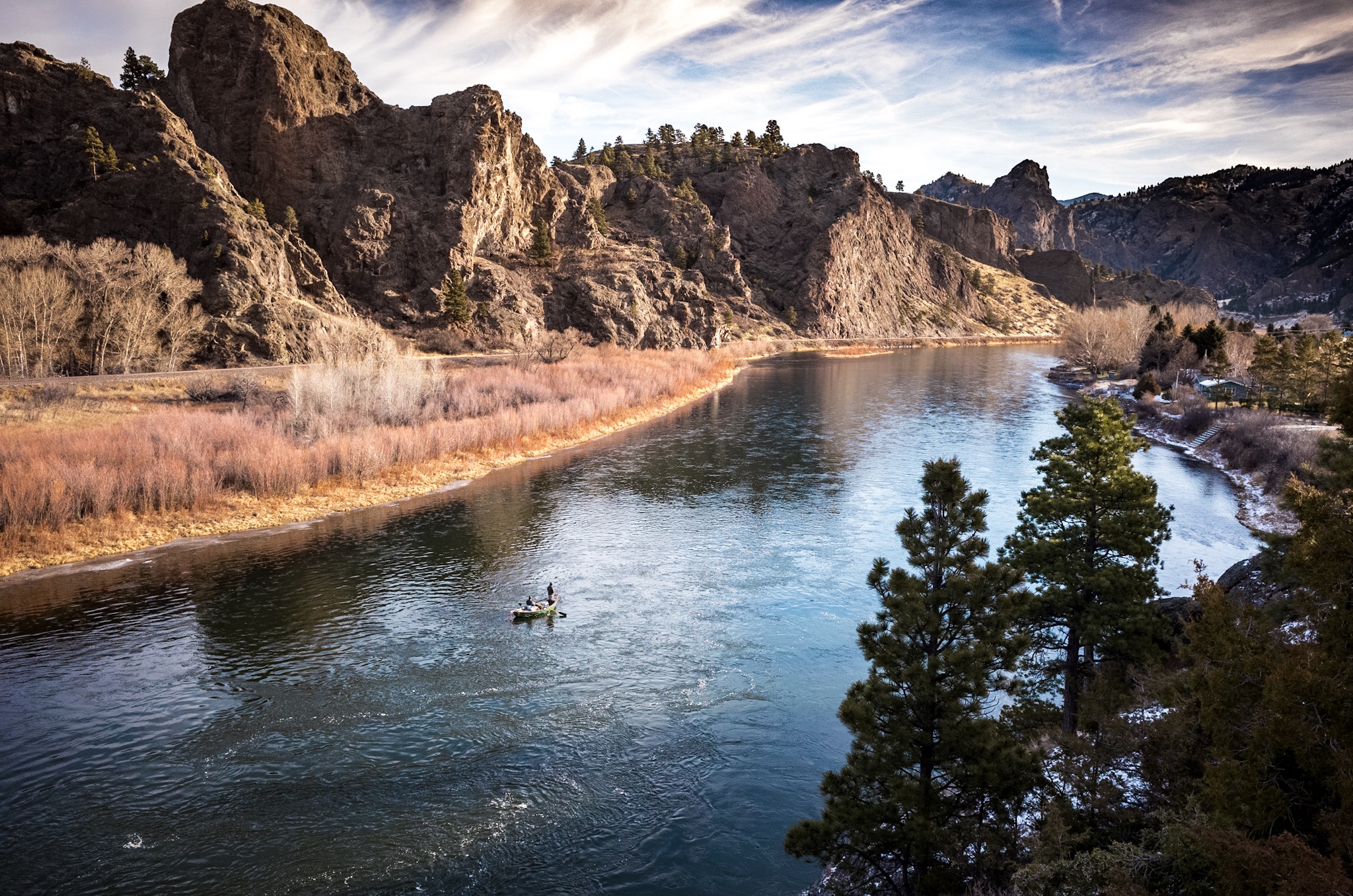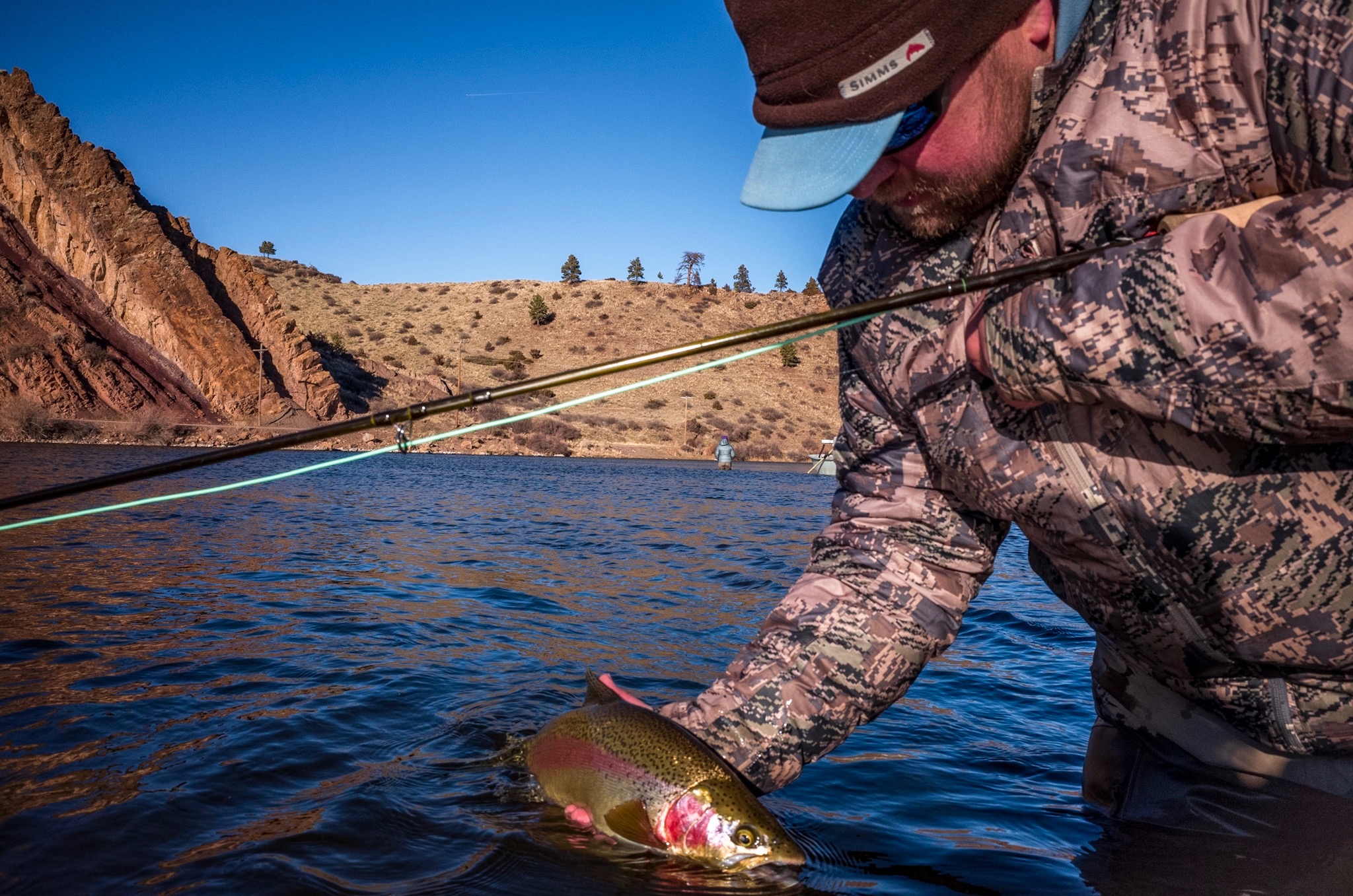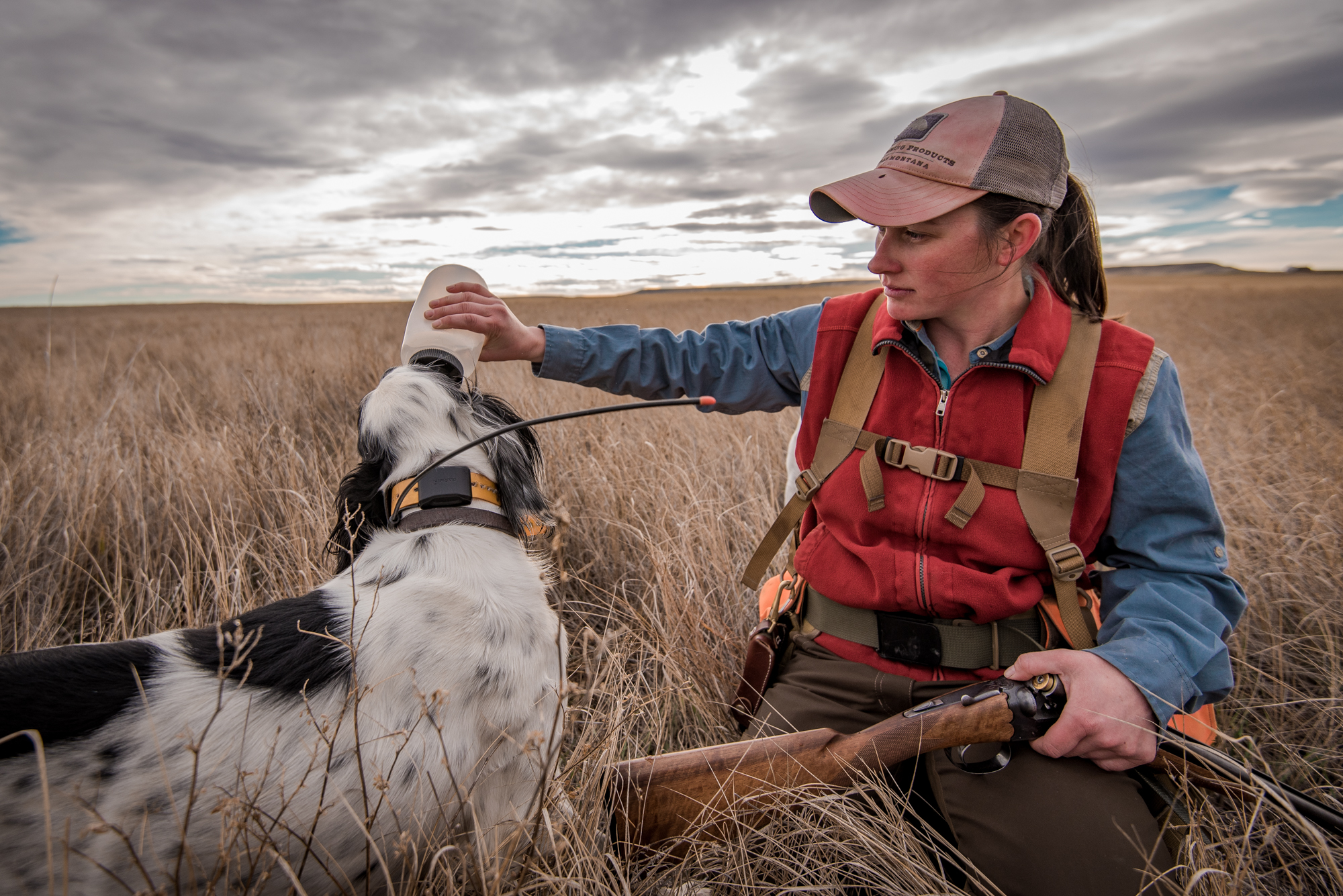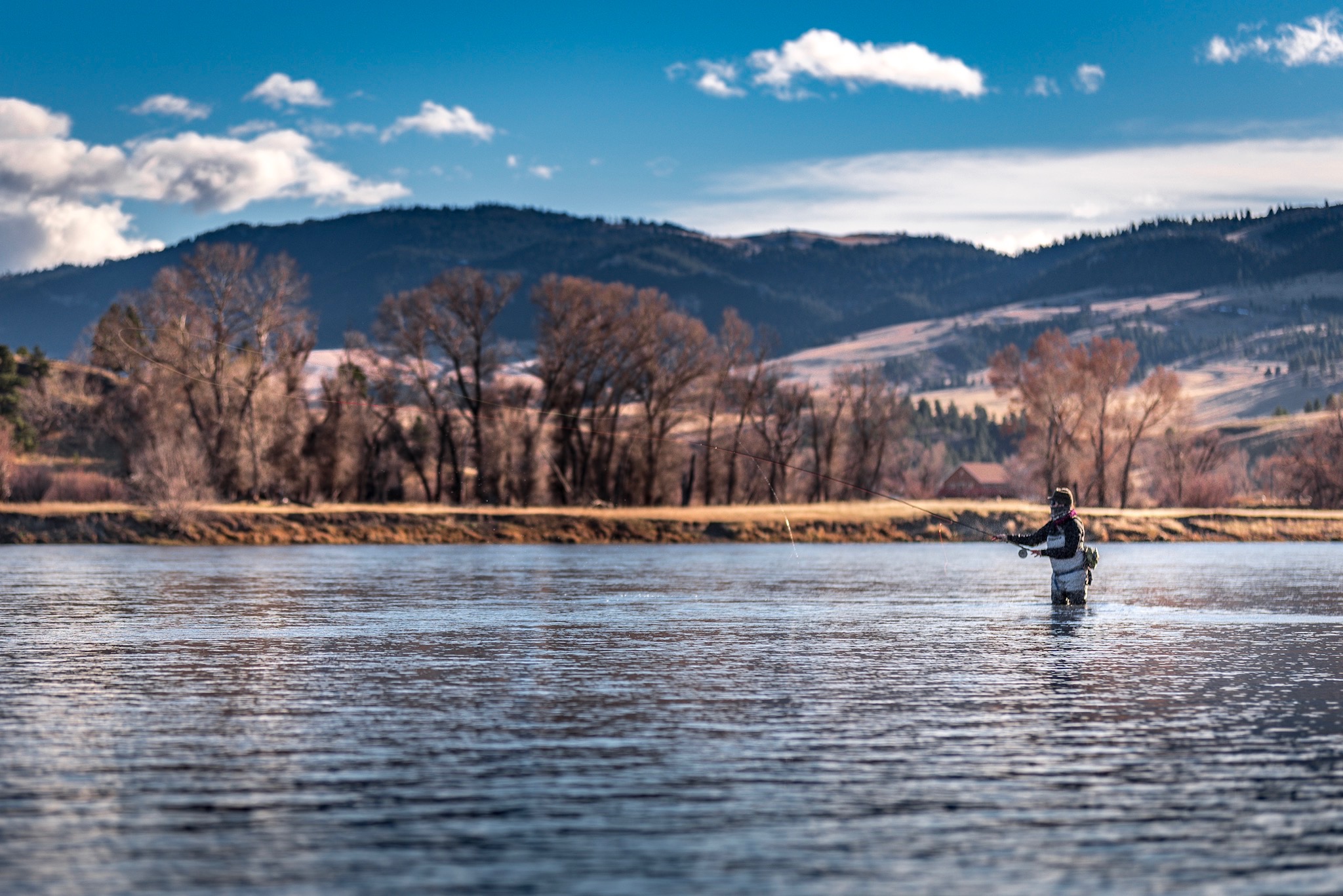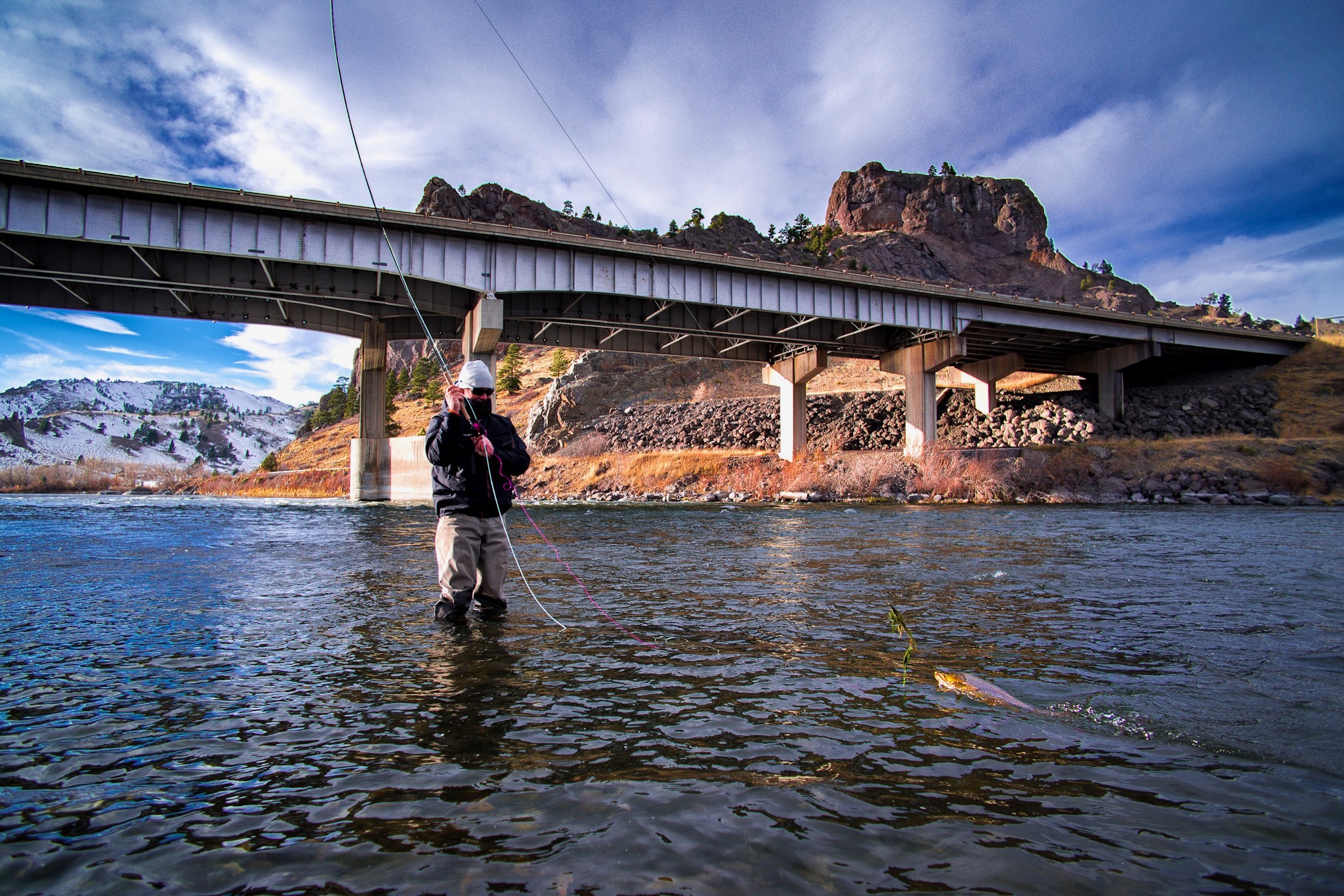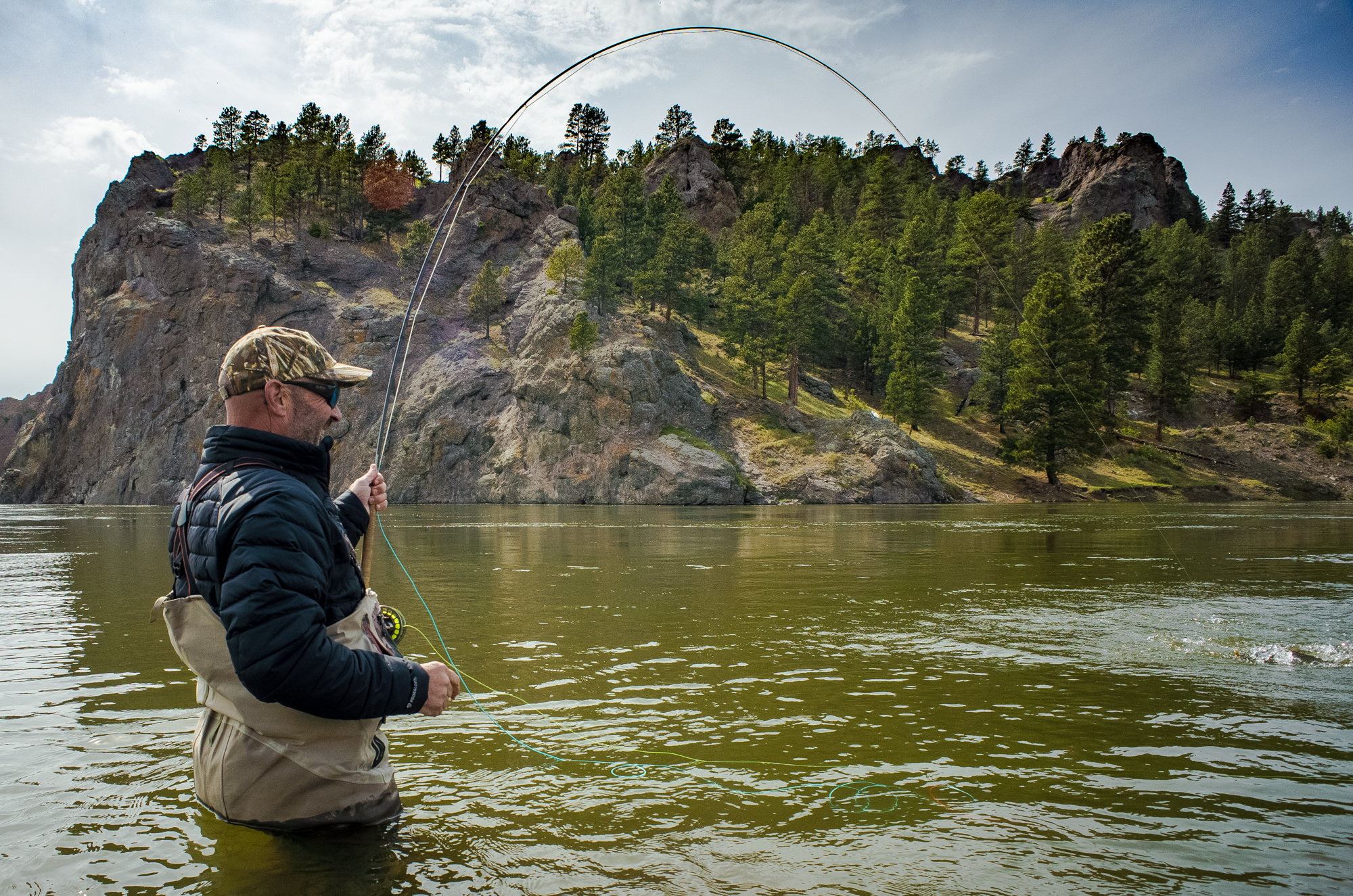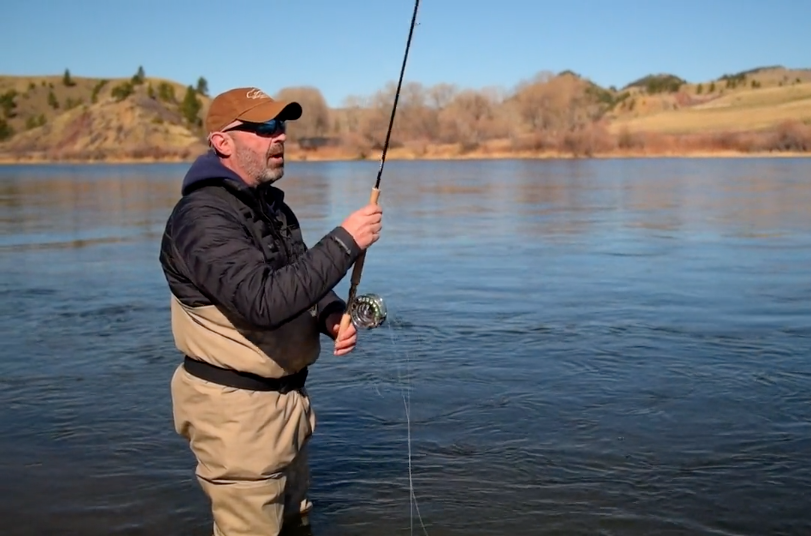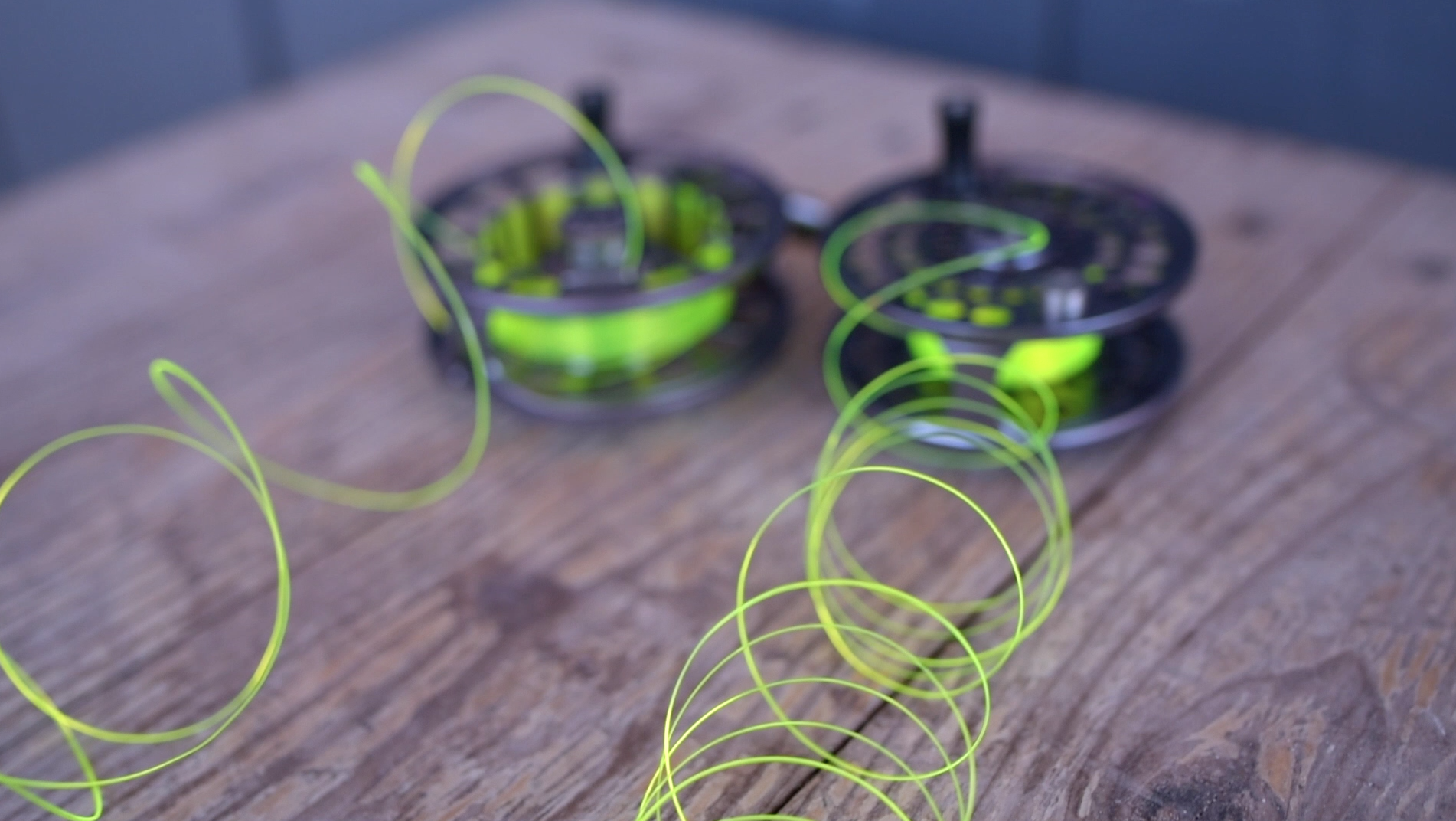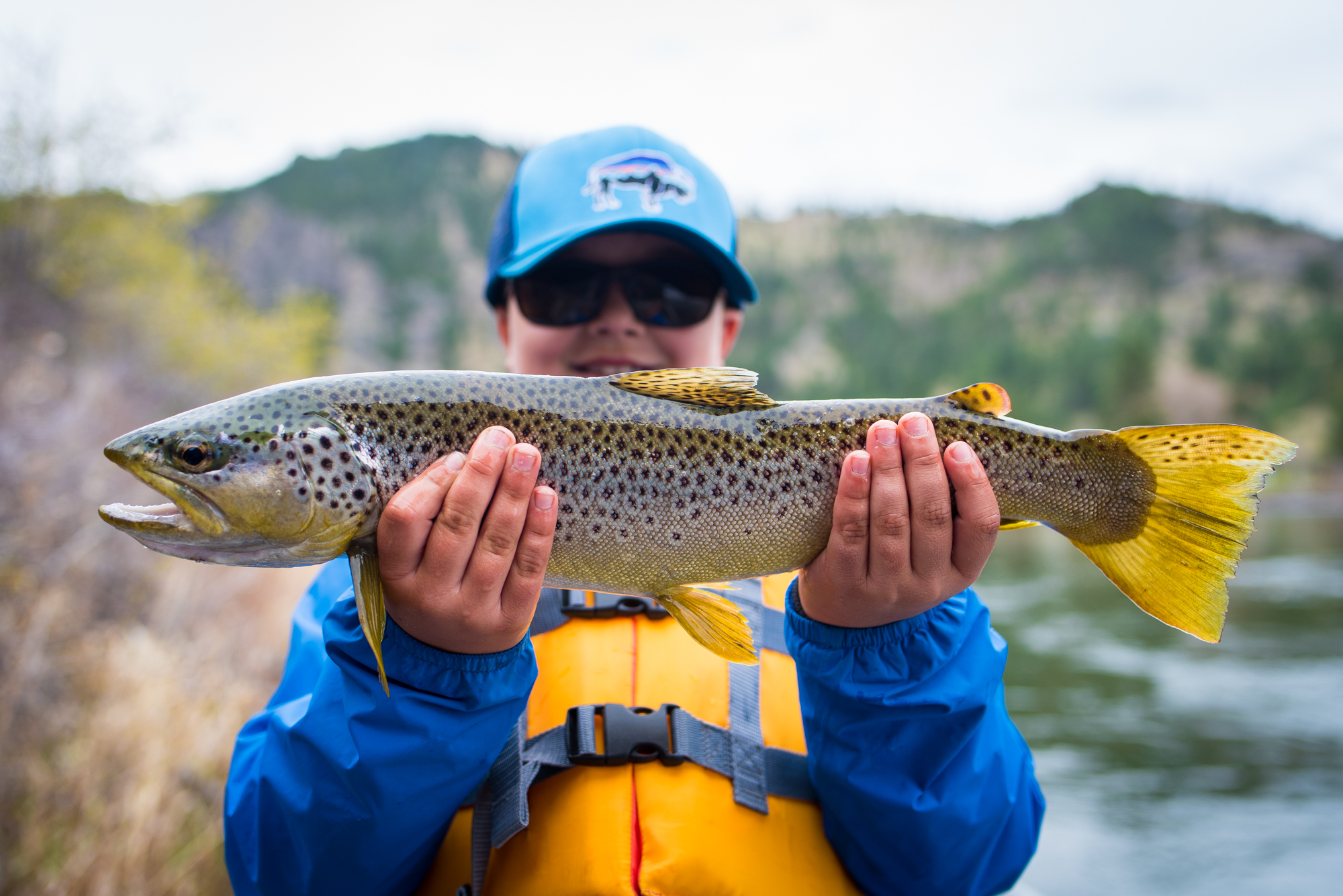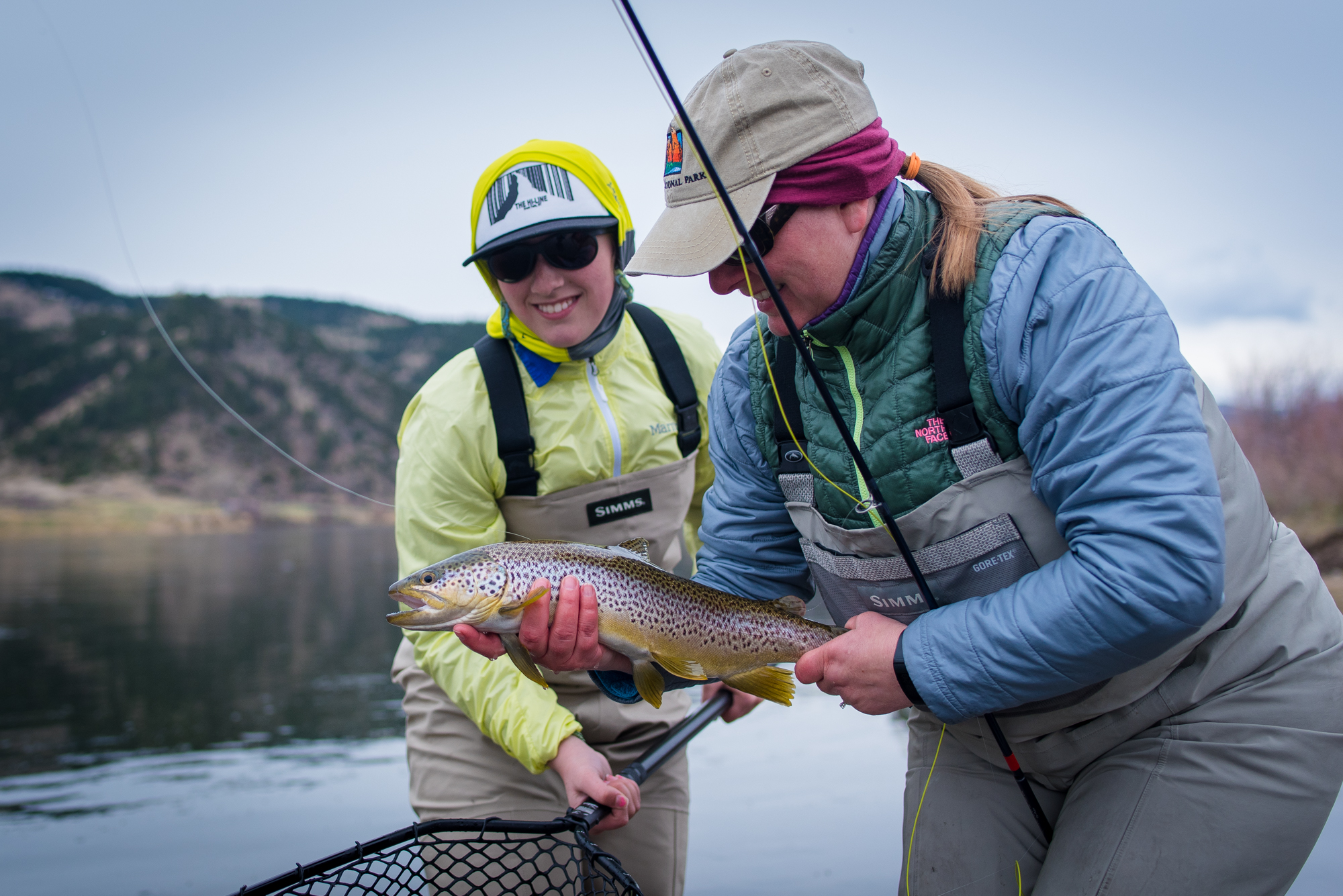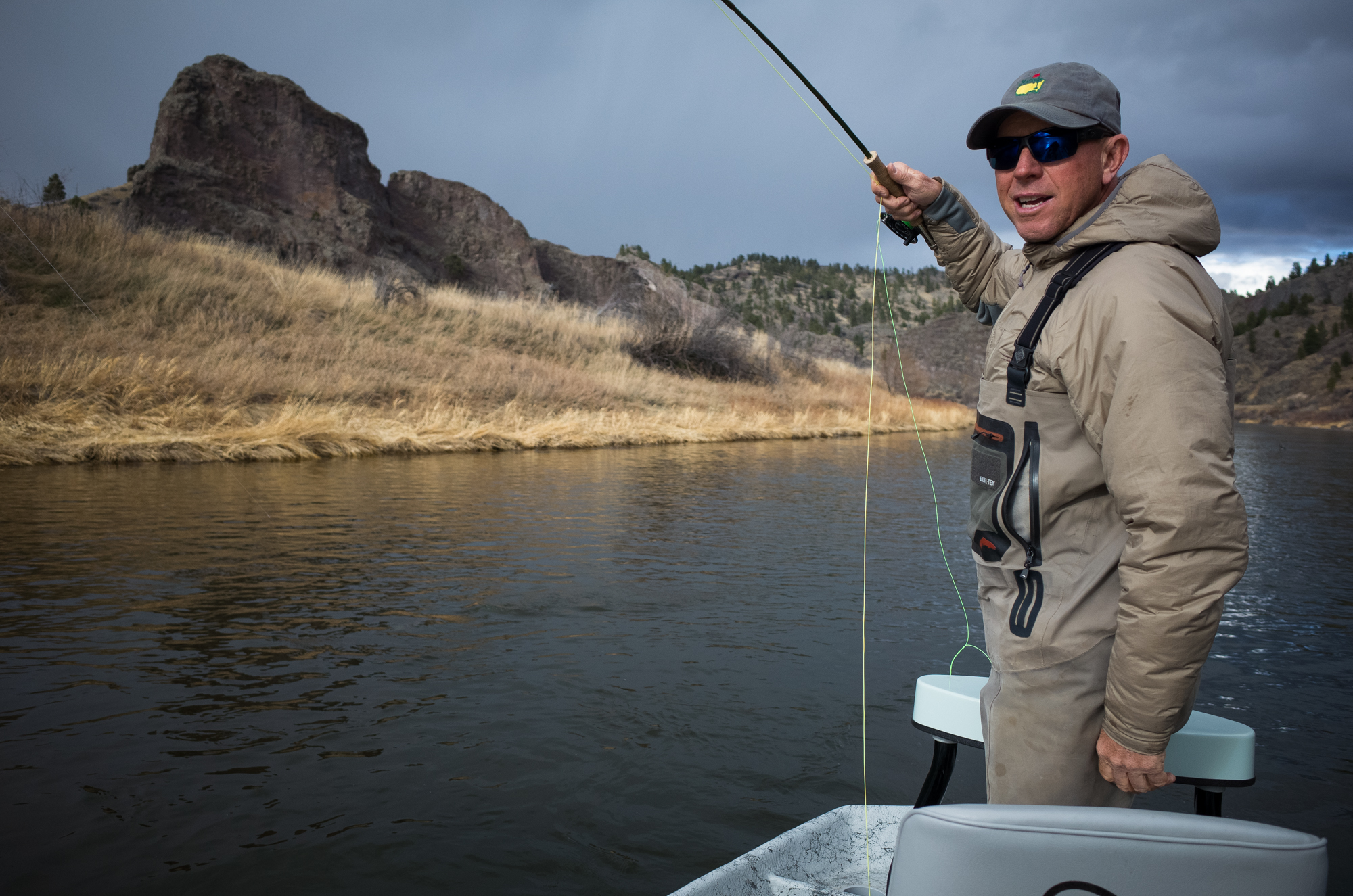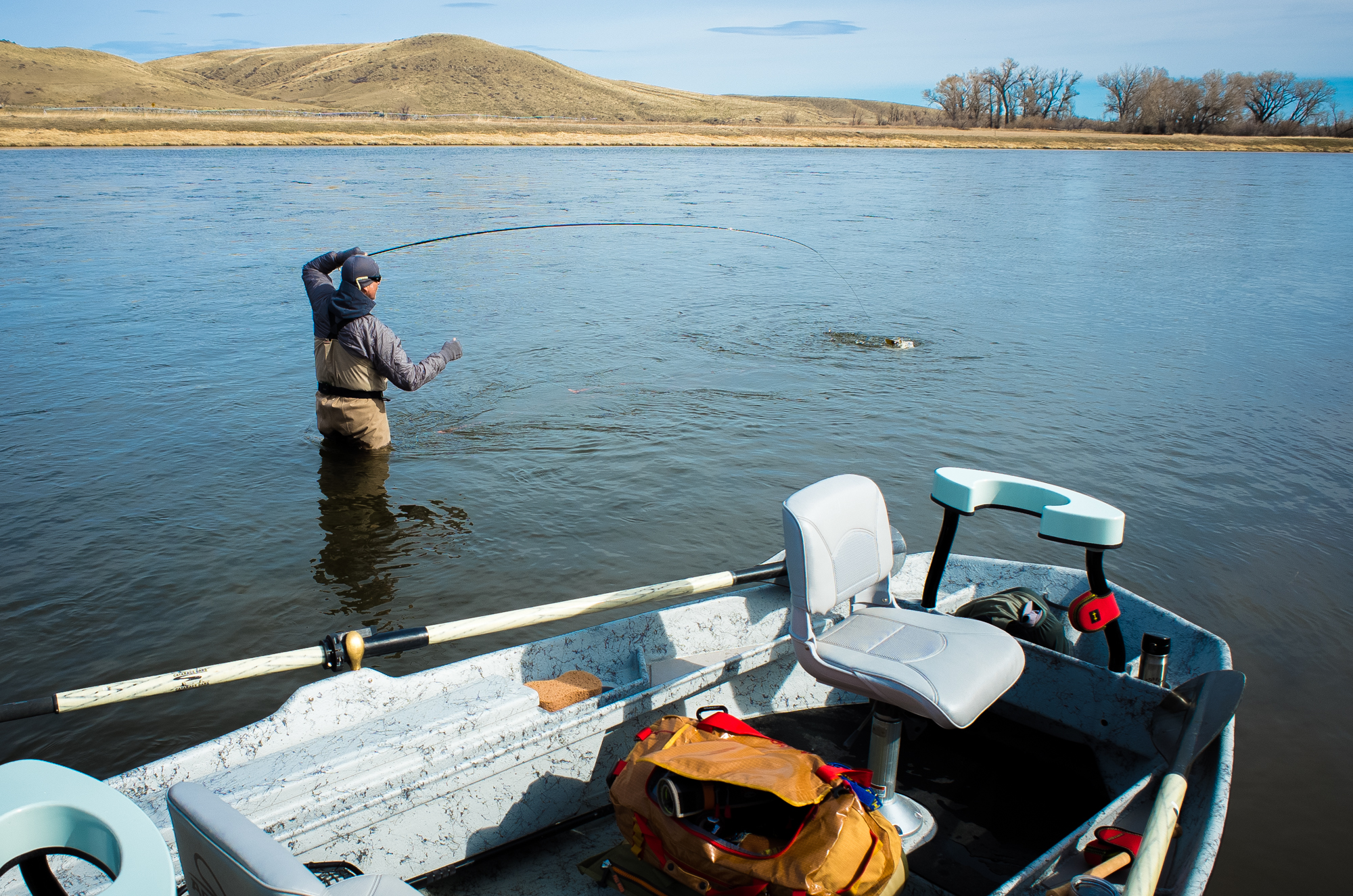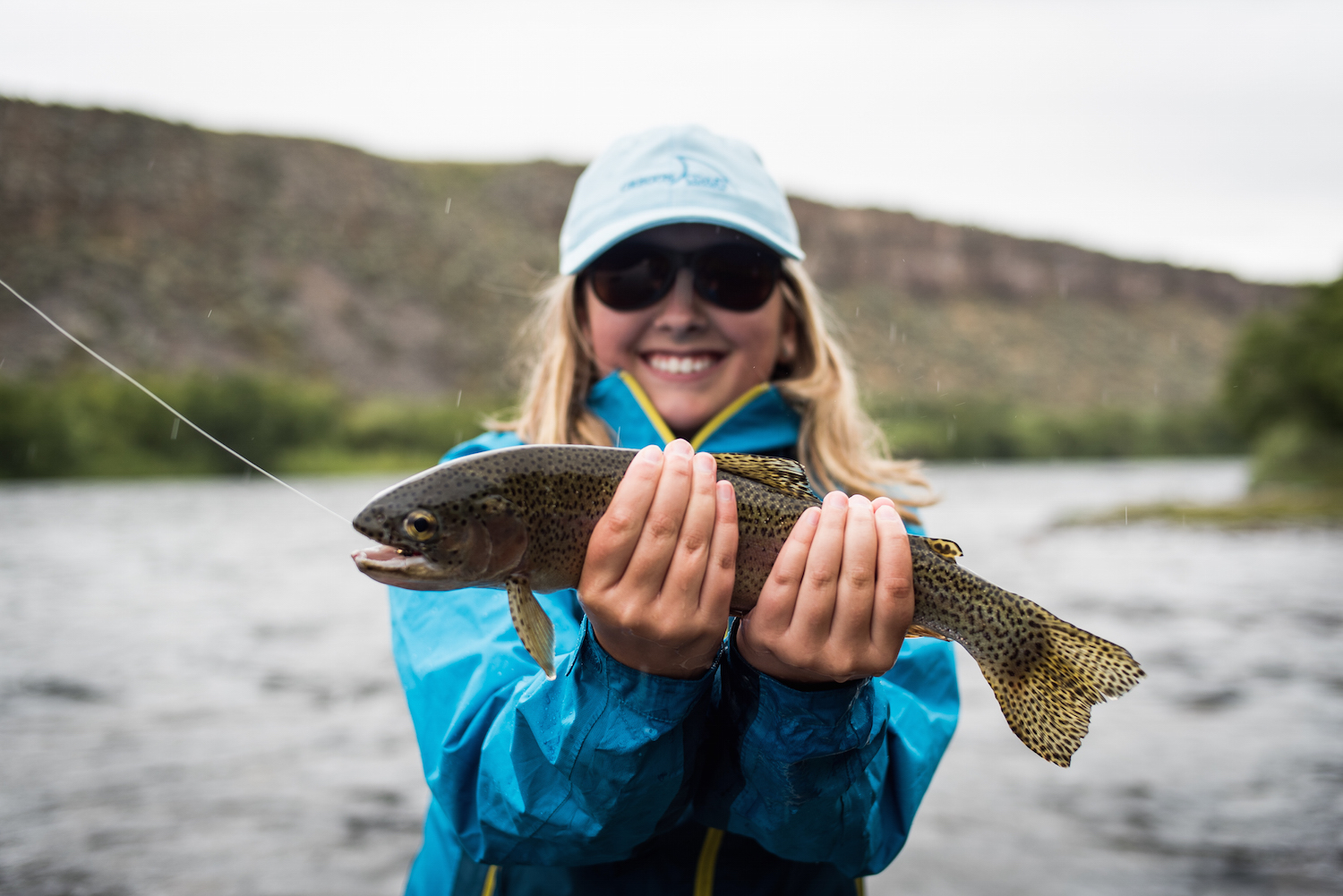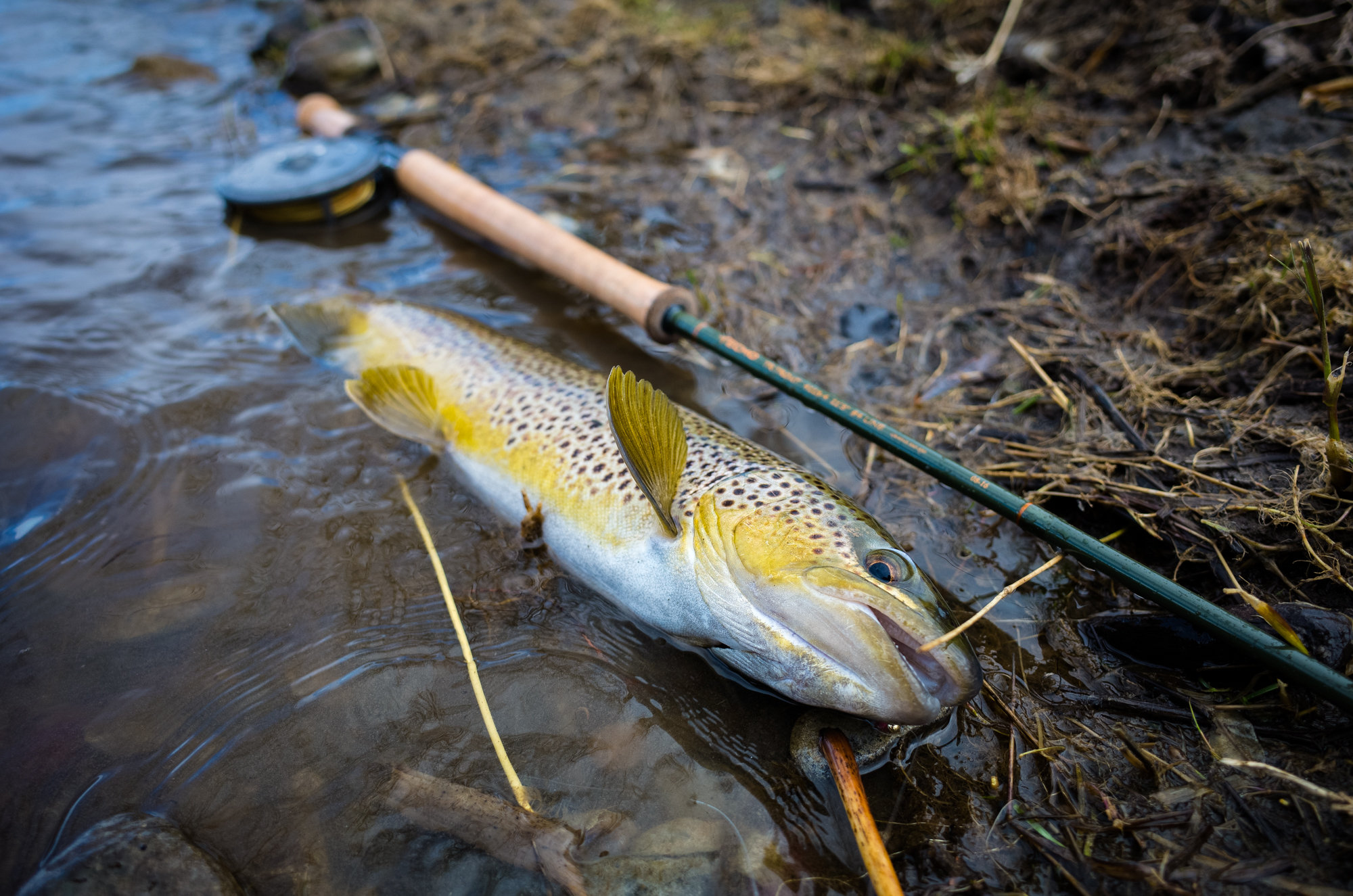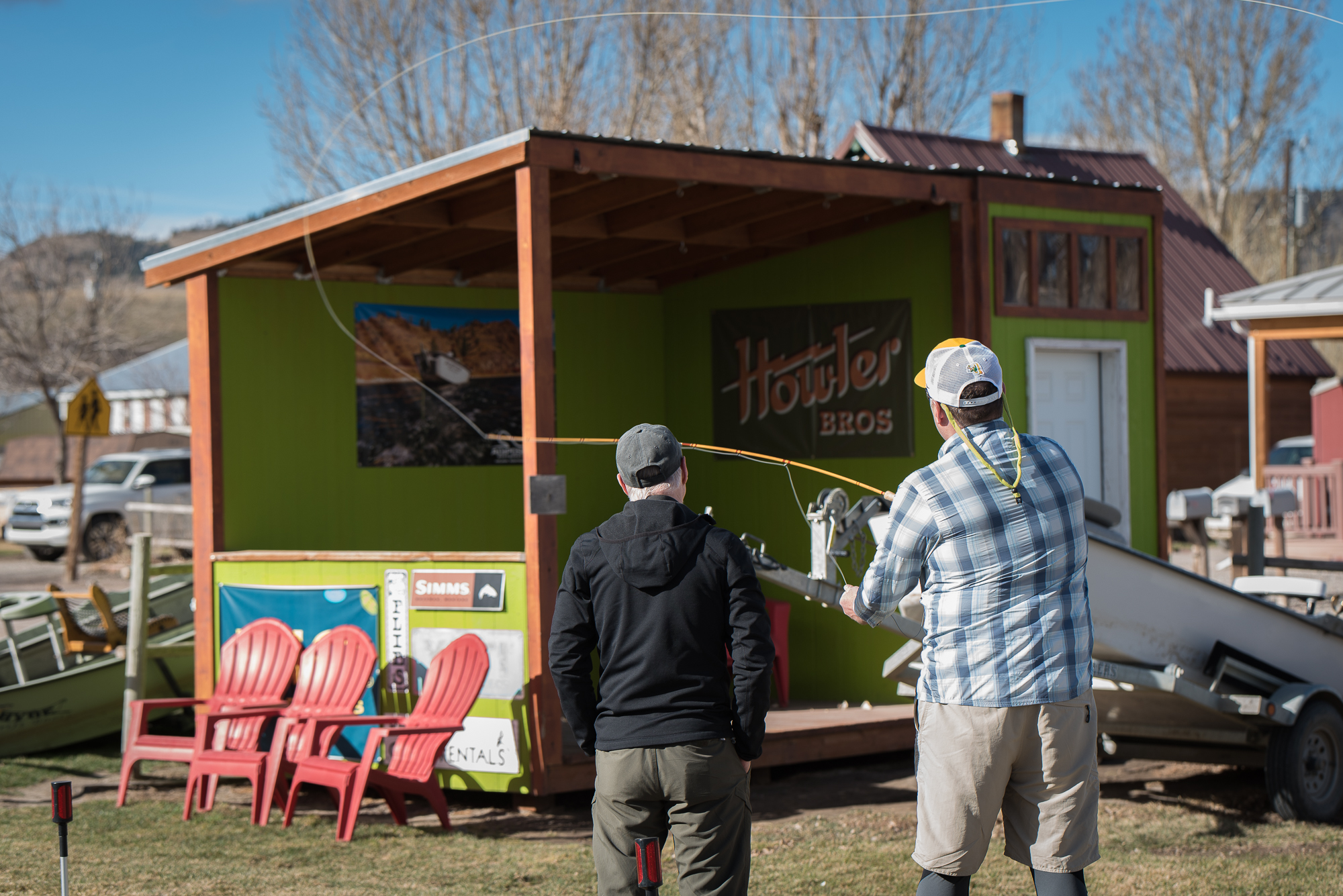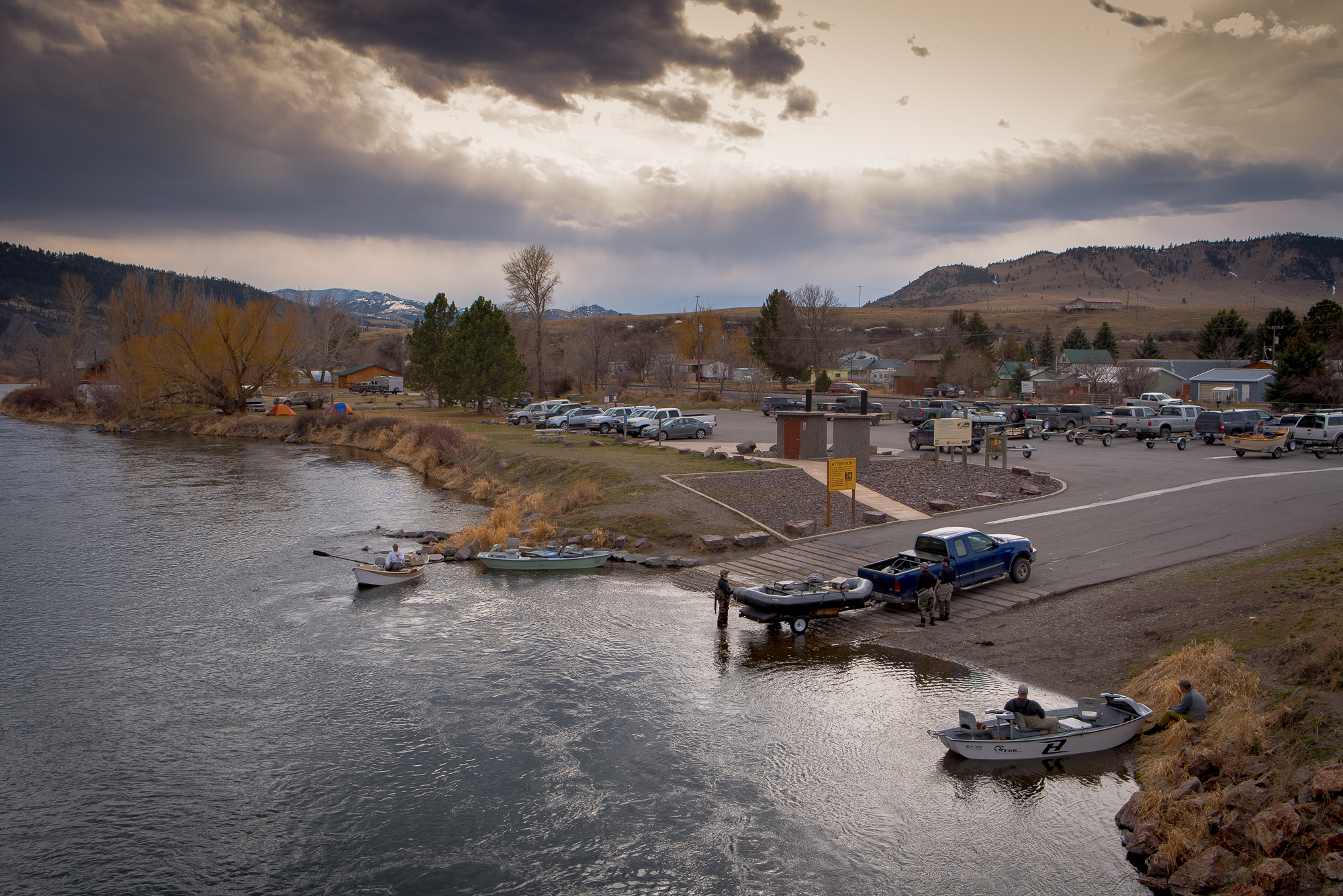[vc_row][vc_column][vc_column_text]The 2017-18 Spey season has begun on the Missouri River, and it’s time to layout the gear we use while swinging the Mo’. Last season we began a transition from 6 and 7 weight spey outfits down to true ultralight rigs in the 2,3 and 4 weight class. That transition is now complete. For 95% of our fishing we are using true “troutspey” equipment. We occasionally may reach for a 6 weight, and the shop will continue to sell lines, tips, reels and the other gear you need to rig rods up to 9 weight. Our clinics – and this post – will focus on equipment below 360 grains (5 weight).
WHY SO LIGHT?
Remember, those 2, 3 and 4 weight spey rods that sound so light, effectively correlate to 4, 5 and 6 weight rods. So really, your using standard gear. If you’re new to spey fishing, these rods will feel much more familiar to your hand. Most are 10’6″ – 11’6″ in length. Your reel will be a 5-7 weight reel. In terms of total weight, you’ll not be far off from your 9′ #5, though the swing weight will be increased significantly.
These ultralight rods are a pleasure to fish with and you won’t feel overmanned with a 14″ trout on the end of your line. Softer presentations can be important, especially when fishing soft hackles, and these sticks do the job when lined properly. We’re fishing for trout after all, so why not use some trout gear. Thanks to manufacturers like Echo, Scientific Anglers, Sage, OPST and RIO, trout spey anglers now have a decent amount of gear to choose from.
RODS
The ECHO TR Trout will continue to be our most popular spey rod for the 2017-18 season. It’s a great rod, finished nicely and really does everything you’d ask from a trout spey rod at a reasonable price of $379. Everyone seems to like the army green/orange tipped cosmetics, and many folks comment on the slender grip, which can make a long day of casting more comfortable. Like all of the TR family, these rods throw both Scandi and Skagit lines with ease. If you like to throw giant Galloup-esque flies, you can comfortably over line these rods to increase turnover power. Pretty much all of our staff owns at least one of these rods, and we use them for demo rods in our casting clinics. We’re very familiar with them, and have matched them with nearly every line we carry, so we can easily get you paired with the right line for your casting and fishing style. If you’re looking for a 2 weight, however, you’ll have to look elsewhere. The Echo TR comes in 11′ #3 and 11’3″ #4 variations. Also, we still throw the 12’6″ #6 occasionally on the Missouri, and it’s an excellent choice for Summer Steelhead on the Ronde, Deschuttes, etc. Great rod, great company and great customer service.

The SAGE ONE Trout Spey is one of the first – and arguably the best – dedicated Spey (not switch) rod on the market. Designed with help from Skagit guru Mike McCune, the Sage is a really sweet caster designed to throw relaxed sustained anchor casts. As you’d expect from Sage, the finish is top shelf like the action. You will definitely feel a weight difference in your hand when you pick up one of these vs. a price-point rod like the ECHO TR. The 10’9″ #2 is the preferred rod for swinging small and medium sized soft hackles on lighter tippet, while the 11′ #3 is the daily driver that will throw everything up to about a heavy #4 streamer. A perfect rod for the Missouri. We also like the 11’6″ #4 for throwing Scandi lines. Unlike the 2 and 3, the 4 is a rebranded rod from the previous ONE Switch series possessing a little faster action. While it will definitely throw a Skagit head, it shines with a longer and lighter Scandi head. Price of entry is steep, however, at $950. If you’re a dedicated spey guy or gal and a fan of Sage, you’re all in. If you’re new to the sport that may be more than you want to spend, and we don’t blame you.

New to Headhunters this season are Gary Anderson Custom Rods (ACR), from the Rogue River country in Oregon. While his name may not be familiar in Montana trout circles, Gary Anderson is widely known in the west coast spey community. His rods are used by some of the best two-handed casters in the sport, including our own Whitney Gould. The ACR Nova lineup will be first in the shop. The performance and finish of these rods easily outpaces the price, and Gary has created more troutspey models than the rest of the industry combined! The Nova comes in at $450 and is available in 2, 3 and 4 weight configurations. We will likely be bringing in some of ACR’s Elite series rods as well. We expect Nova rods to be one of our best selling models in 2018. Demo rods available some swing by and grab one for a pass or two.
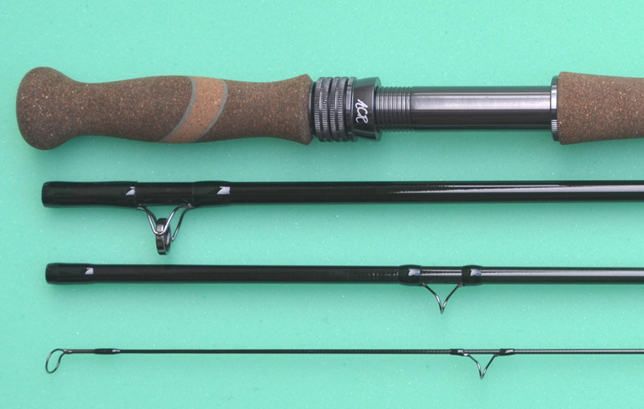
The Orvis Clearwater series remains polar for those looking for Steelhead or Steelhead/Trout crossover rods. The 12′ #5 Clearwater is the only 5 weight rod we stock, and it’s an excellent choice for big streamers on the Missouri or Yellowstone, as well as lighter Steelhead work on the Grande Ronde. This would also be an excellent choice for Alaska or Patagonia trout, or Pink Salmon. The 12’6″ #6 and 13′ #7 are also popular choice for Steelhead, the latter being one of our more popular models for winter Steelhead on the coast. For newbie trout and Steelhead spey anglers, the $349 price point is easy and leaves plenty of cash for heads and tips. Orvis is not the biggest name in Spey, but everyone who throws these rods likes them. Hopefully they will enter the troutspey arena in the future…
The ECHO Glass Two Hand series remains popular with the crowd that likes, well… fiberglass. These rods have methodically slow actions that really throw some strong, nice loops. And at $279 these might be the best deal going if you like the action and the super retro honey colored blanks. The 10’6″ #3 is an excellent soft hackle rod with a soft tip that protects lighter tippets and helps increase hookups. The 10’8″ #4 is a good daily driver, especially if you fish smaller water or fish in situations that don’t require longer casts in windy conditions (sound familiar?). The 12’4″ #6 and 12’9″ #7 are also excellent rods for both big trout and Steelhead, but smaller anglers will definitely feel the extra weight after fishing one for a full day.
Thats our core group of rods, but always have some others bouncing around the shop and commonly bring in more models when our staff gets a chance to try and evaluate other rods on the market. If you’re interested in any other models ask one of us and we will likely have tried it.
LINES
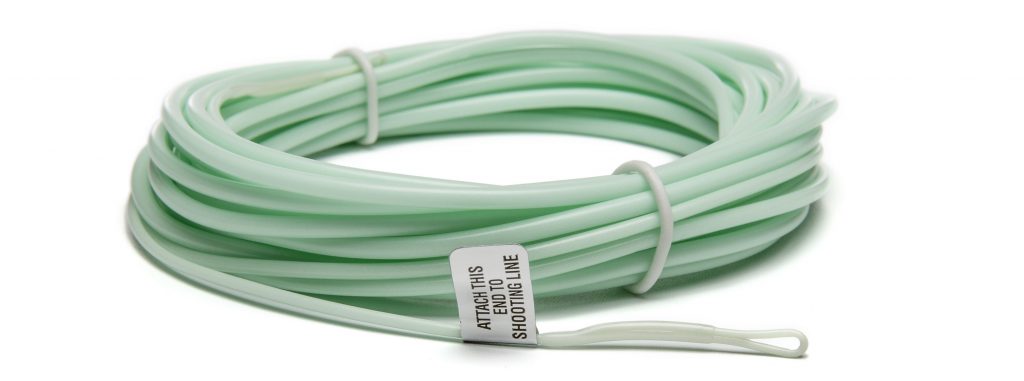
Lines are the whole deal, right? At least that’s what I tell folks at our spey clinics. And it true. A couple of years ago there were very few lines available for smaller trout spey outfits. None of you defined them as “good” lines. Suddenly, we have choices. And it’s changing the way people fish for trout during late fall and winter. Thanks to the advancement of lines designed specifically for lighter trout spey applications, more and more anglers are out there swinging on their feet.
Remember, we have all of these lines in demo, and encourage you to try before you buy! Once upon a time I though when we finally got the lines we needed in the lighter weights the “grain window” would tighten up and we see less variation in line recommendations and preferences. Not true. I’m continually amazed at the wide grain window I see people choose for each rod in our shop. So take a few heads out for the day and see which you prefer.
Olympic Peninsula Skagit Tactics (OPST) really got the game going with their Pure Skagit Commando Head ($55), designed for shorter single and two-handed rods. These lines changed the game in our shop. We finally had the right lines to match up to our UL two-handers and single handed rods. The Commando is our most popular selling Spey line, and brings incredible versatility to the swing game. Customers and staff use these on two-handed rods from #2 weight on up, and we sell plenty to anglers who use them on single hand rods both while wading and from the boat. They have a nice smooth taper that throw fast tight loops and behave like a quicker Scandi line when downsized with a floating tip.
The new Scientific Anglers Spey Lite series brings us the first Scandi line created specifically for UL spey applications. Something we’ve been waiting for, and are excited to finally add to the arsenal. Near surface presentations are ofter better than deep presentation on the Missouri (like now as I write this!), and the Spey Lite Scandi throws a long way with power. Swinging soft hackles is an increasingly popular tactic, and this is the best line for that purpose without a doubt. The Spey Lite Scandi is an integrate line (1 piece) with a visual, audio and tactile transition zone that is easily to hear and feel in low light conditions. You can add a “poly-leader” as well to achieve a little depth. SA also has a Spey Lite Skagit head that is available in both an integrated and shooting head configuration. Like the Scandi version, it’s an excellent caster that throws tight loops, but with more power to turn over bigger flies and tips. I’ve been using the Shooting head model with mono running line, but have come to like the textured transition of the integrated Scandi model so much that I may switch to the integrated Skagit. It would also be nice to lose that loop-to-loop connection when retrieving a fly or landing landing a trout. The only downside of an integrated line is price ($89 vs $49 for a head) and the fact that you really need to dedicate a reel to that line.
The Airflo Skagit Scout is another very popular line in the shop. The Scout seems to be more popular with those seeking to perfect that effortless sustained anchor casting stroke. I also notice the anglers who like this line are the ones who like things overweighted a bit. The Scout throws big flies and heavy tips with ease, and is one of the better choices if you’re the type who always has 12′ of T8 and a Sex Dungeon on your rod. If you do a lot of winter Steelhead fishing you will quickly identify with the feel of this line. Very popular with the ECHO TR #4 and a favorite of local outlaw fly tier “7weight”. Normal price of $59.
RIO’s Skagit Trout Max was designed to match up with the Sage ONE Trout Spey rod series, and it’s an excellent match on those rods as well as the rest. The Trout Max series are all 11′, and are the shortest heads we’re aware of. Depending on grain weight, this can be 1-5 feet shorter than competitors heads. This creates a very powerful and compact system that can turn over larger flies than you would expect in relation to the line weight. The short head is also a blessing for those that retrieve the fly (instead of a static swing), giving you a few more feet to work that bug back before that shooting line/head connection jams in your tip-top. Watch some of videos of Mike McCune and you can see how easily this line casts in the hands of a pro. The Skagit Trout Max is $50.
SHOOTING LINES
We carry shooting or running lines from OPST (mono), Scientific Anglers (coated), Airflo (coated) and RIO (coated). If there is any are where even novice spey anglers quickly form an opinion, this is it. In general, the same guy who likes a Scandi line, also likes a coated running line (and probably integrated as well), which is good, because that’s all a pretty good match. And conversely, the guy who likes a slow, sustained anchor Skagit cast probably likes his shooting line to be mono. Again, this is good and all pairs real well.
For coated lines we have several, but the Scientific Anglers textured shooting line (.032″) is probably the most popular. It’s small enough to shoot well with lighter heads (though nothing like mono), and the texture that helps shoot ability also helps with grip and line management. The RIO ConnectCore Shooting line is also popular, but I think the fact that it comes in 4 sizes just confuses people. It’s good stuff, shoots really well and comes in a size smaller (.026″) than the SA. Some folks consider it a bit “tangley”. Both of these excellent shooting lines are $59, so significantly more expensive than mono.
OPST Lazar Line is our primary monofilament shooting line, and it comes in several sizes and colors. We also have some general purpose bulk mono at our reel winding station that you can get spooled up with. Both work fine but the OPST seems to last a little longer and is available in more and larger sizes. All mono stays kink free much longer when used with a swivel in-between the mono and the head (ask at the shop if you don’t know about this). And remember, mono is cheap, but it’s also disposable. It’s not going to last forever.
TIPS
We have an incredible selection of Skagit tips and “poly” leaders in the shop, and I cannot claim to have tried every one of them. The iMOW series from RIO ($25) is certainly the most popular, and we really like the “black/white” color combo that makes it easy to identify each tip without have to search for microscopic printing. As the industry “standard”, I suppose we compare everything to them, which is a testament to great design from McCune, O’Donnell and Ward (MOW).
Speaking of microscopic printing, Scientific Anglers has the market cornered with their line markings. I can actually read them without readers on every one I’ve ever picked up. Bravo. In terms of fishability, I really like the TC Skagit Tips ($25) and use them often. The “light” 80 grain series that we use on our troutspey outfits is also 8′ instead of the usual 10′. I like that. It gets down all I need (and not too much) and I don’t miss that extra two feet while casting. These are dual density tips (S1/S2, S2/S4 etc.) so it is a different system than the T8 material that RIO uses. We do not like the bright optic green/white floating tip. Too bright for smart trout near the surface.
OPST makes Commando Tips ($15-$24) to match their Commando Heads. They come in 5′, 7.5′ and 12′ lengths in 3 different grain weights and 3 different sink rates called “riffle” (slow), “run” (medium), and “pool” (fast). It’s a little bit confusing, and I’ve always thought these tips fished a tiny bit deeper than the rest. The tree lengths do allow you to pick a tip that does exactly what you need it to do, however. I think the little 5′ tips will find a home in many head wallets. I would probably pick the 12′ “pool” as the deepest fishing tip if I had a need to get really deep. Like where Walleye live.
SINKING LEADERS (aka POLY-LEADERS)
Used on Scandi lines and heads, single handed lines and occasionally on very light Skagit heads, sinking leaders are an effective and economical way to add some depth to your system. RIO make the VersiLeader ($15) which comes in a wide variety of sizes and sink rates, is our most popular sinking leader. I always have a few on me, usually in intermediate and 3ips sink rates. The only knock on VersiLeaders is that that are a bit fragile. Stretch them to hard or rake then over the rocks a few times and they begin to fall apart. But at $15 its not a big deal. You’ll likely get a season out of them.
Scientific Anglers recently introduced Sonnar leaders ($15), which are more durable, stiffer (which may or may not be good), and have a coating that extends to the tip (VersiLeaders have a short piece of mono at the end). You can easily throw a perfection loop in the coated tip. They seem to have a stronger core and I have not been able to produce any coiling by overstitching them. They have also proven to be very durable and are a different execution of the sinking leader. I really like them and have been using them exclusively on my Spey Lite Scandi setup. So far so good, check ’em out…
REELS
In past years we discussed reels specifically for two-handed rods as we were often using larger 8-10 weight reels for our 6-8 weight rods (the oversize is to accommodate the extra heavy spey lines). We still carry and recommend larger reels for Steelhead rods like the Orvis Battenkill Spey, Hatch 7plus and 9plus, and Galvan Grip. But as we’ve downsized into UL Spey rods we find ourselves using typical trout reels in the 6 and 7 weight range. We do recommend larger arbor reels for those using mono shooting lines, but other than that just use what you want.
THE LEAST EXPENSIVE WAY TO TRY THIS
If you’re interested in giving this a try, but are not interested in shelling out for a whole new outfit, here’s the best way to try it on the cheap. Is all you need is an understanding of how to execute a spey cast or two.
First, grab 5 or 6 weight fly rod from your quiver. Doesn’t have to be fancy, fast action or pretty. Any old crapper will do. Longer is good, and so is slow action. Second, grab a fly reel to match your rod (5 for a 5, etc.) and strip the line and backing off of it. Now, head down to your local Big Box store and buy a 100 yard spool of 20 or 25 lb. monofilament and spool it up on the reel. Stiff stuff is good, like the stuff that says “catfish” or “big game” on it. Tie a big Surgeons loop in the end of the mono.
Now, you need to get out your wallet. Find a shop that sells Trout Spey gear and pick up a Skagit head. Its going to cost you around $50. Any of the above Skagit lines will work, but get a Skagit head (not a switch line, nothing integrated, and not Scandi heads) and make sure its short… 11′ – 16′. This Skagit head/mono combo is going to be the easiest to learn with, and show you best what can be done with zero room behind you and a spey cast. You’ll want something around 330 grains for your 6 weight. 250 for your 5. Look in the sale bin, you can fudge it heavier, but don’t go lighter. You’ll also need a Skagit tip, and I’d recommend a RIO iMOW tip in the 7.5 intermediate / 2.5 sink configuration ($25). You also might find the older MOW tips (not iMOW) in the sale bin. If so, get that one. Put 5 feet of 0X on the end and your favorite streamer. Go fishing.
So, for about $75 bucks you can get yourself setup and see what you think. This will be an effective outfit. If you really get into it, you’ll probably want to get a dedicated spey rod, but you won’t need to. You’ll likely be surprised where and how effectively you can fish, or maybe you’ll hate it and never try it again.
You can also attend one of our free trout spey clinics this winter. The next clinics are on December 2 or 3. Call the shop to sign up at 406-235-3447.
[/vc_column_text][/vc_column][/vc_row]
